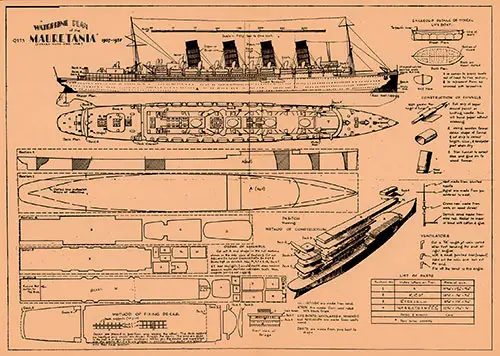RMS Mauretania (1906) Archival Collection

The RMS Mauretania circa 1910. Detroit Publishing Company No. 022638. Library of Congress 2016806527. | GGA Image ID # 1ba9129339
- Mauretania (1907) Cunard Line Ship's History (Brief)
- Passenger Lists
- Brochures
- Menus
- Sailing Schedules
- Services
- Advertisements
- Passage Rates
- Books
- Excerpts from Information for Passengers
- Back Cover Images
- Overview of the Mauretania
- 24 Facts About the RMS Mauretania (1906)
- Deck Plans
- History & Background
- Passenger Accommodations and Interior Photos
- General Information and Work Spaces
- History of Service
- Key Voyages
- Conversion to Oil Burner
- Final Voyage
- Officers and Crew
- Additional Photos
- FAQs
- Speed Records
- Bibliography
Built by Swan, Hunter & Wigham Richardson, Ltd., Wall- send-on-Tyne, Newcastle, England. Tonnage: 30,696. Dimensions: 762' x 88' (790' o.l.). Propulsion: Quadruple-screw, 26 knots. Four steam turbines. Masts and Funnels: Two masts and four funnels. Launched: September 20, 1906. Passengers: 563 first, 464 second, 1,138 third. Maiden voyage: Liverpool-New York, November 16, 1907. Speed Records: Held the trans-Atlantic speed record, along with her sister ship for a number of years. In June 1909 she made the eastward crossing in 4 days, 17 hours and 21 minutes. Rated at 68,000 shaft horse-power. Equipped with 23 double and 2 single ended boilers working at 200 lb. pressure. In September 1928, made the Cherbourg to Ambrose Light crossing in 5 days, 2 hours, 34 minutes, a remarkable feat for a twenty-two year old liner, especially as she was at the time equipped with her original "Parson's" steam turbines. Fate: The grand old ship was finally broken up by ship- breakers at Rosyth in 1935, thus ending the career of one of the most famous and successful of Atlantic liners. Sister ship: Lusitania.
Return to Content Links

1908-04-11 RMS Mauretania Passenger List
Steamship Line: Cunard Line
Class of Passengers: Saloon
Date of Departure: 11 April 1908
Route: Liverpool to New York
Commander: Captain John Pritchard.
Notable Passengers: Sir Arthur Herbert Dyke Acland, 13th Baronet PC, John Washington Butler, William D. Gordon, Cecil B. Hartle, Sir James Knott, 1st Baronet, Alfred William McCune, General Sir Arthur Henry Fitzroy Paget GCB, GCVO, PC.

1909-10-06 RMS Mauretania Passenger List
Steamship Line: Cunard Line
Class of Passengers: Saloon
Date of Departure: 6 October 1909
Route: New York to Liverpool via Queenstown (Cobh)
Commander: Captain John Pritchard
Notable Passengers: Charles Frederic Moberly Bell, Richard Hartshorne, Robert Chambers Reamer, Harry W. Child, Sir Frank Ree, Melville Elijah Stone, Sir William Henry White, KCB, FRS, FRSE.

1911-06-14 SS Mauretania Passenger List
Steamship Line: Cunard Line
Class of Passengers: Saloon
Date of Departure: 14 June 1911
Route: New York to Liverpool via Queenstown (Cobh)
Commander: Captain W. T. Turner, RNR.

1921-04-30 RMS Mauretania Passenger List
Steamship Line: Cunard Line
Class of Passengers: Saloon and Second Class
Date of Departure: 30 April 1921
Route: Southampton to New York via Cherbourg
Commander: Captain Sir Arthur H. Rostron, CBE, RD, RNR.

1928-09-26 SS Mauretania Passenger List
Steamship Line: Cunard Line
Class of Passengers: Second Class
Date of Departure: 26 September 1928
Route: New York to Southampton via Plymouth and Cherbourg
Commander: Captain R. L. Alexander, DSO, RD, RNR.

1930-08-02 RMS Mauretania Passenger List
Steamship Line: Cunard Line
Class of Passengers: First Class
Date of Departure: 2 August 1930
Route: Southampton to New York via Cherbourg
Commander: Captain W. Prothero

1931-08-01 RMS Mauretania Passenger List
Steamship Line: Cunard Line
Class of Passengers: Tourist Third Cabin
Date of Departure: 1 August 1931
Route: Southampton to New York via Cherbourg
Commander: Captain R. V. Peel, R.D., R.N.R.
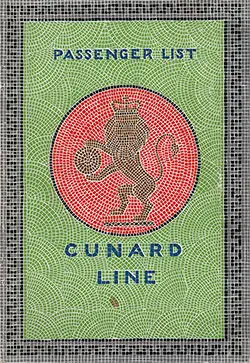
1931-08-22 RMS Mauretania Passenger List
Steamship Line: Cunard Line
Class of Passengers: Tourist Class
Date of Departure: 22 August 1931
Route: Southampton to New York via Cherbourg
Commander: Captain R. V. Peel, RD, RNR.

1932-04-06 RMS Mauretania Passenger List
Steamship Line: Cunard Line
Class of Passengers: First Class
Date of Departure: 6 April 1932
Route: Southampton to New York via Cherbourg
Commander: Captain R. V. Peel, RD, RNR.
Récapitulation: 128 Saloon, 142 Tourist Class, 178 Third Class, 448 Total Passengers.
Return to Content Links

8-Page Booklet/Leaflet from 1910 titled "Famous Cunarders" provided an illustrated introduction to their "A"-List Cunard fleet.
Featured Ships Included the Campania, Carmania & Caronia, Carpathia, Lusitania & Mauretania, Pannonia, and the Saxonia & Ivernia.

Cunard Passenger Log Book - 1913
Rare Third-Class Accommodation on Cunard Liners featuring interior and exterior photographs of the ships and accommodations for third class/steerage passengers. Undated brochure circa 1913.
Its contents were meant to entice the immigrants to book passages to the New World.
Ships Featured: Lusitania and Mauretania, Caronia and Carmania, Franconia and Laconia, Campania, Ivernia and Saxonia, and the Ascania.

Fishguard Information for Passengers of Cunard - 1913
Fishguard is situated on the southwest coast of Wales and is the nearest British port to New York used by Atlantic liners.
It affords the quickest means of reaching London and is also a convenient port for the Continent. Ships Featured: Lusitania and Mauretania.

Cunard Passenger Guide - RMS Mauretania - 1921
The shirt pocket-sized 18-page brochure from the Cunard Line provided a handy reference guide to navigating the RMS Mauretania covering all three passenger classes -- Saloon, Second, and Third—a lot of information but only a few images.

Going Abroad via Cunard and Anchor Lines - 1923
Excellent brochure from 1923 provides numerous photographs, the majority interior views of the many steamships in the fleets of the Cunard and Anchor Lines.
Additional features included Cold Buffets, Assorted Staterooms, and a large format Map of "Strange Lands and Foreign Ports Reached by Cunard and Anchor Passenger Services."
Featured Ships include Albania, Aquitania, Assyria, Berengaria, Cameronia, Carmania, Caronia, Columbia, Franconia, Laconia, Mauretania, Samaria, Saxonia, Scythia, Tuscania, Tyrrhenia, and "A" Class Ships.
Return to Content Links

1934-04-01 RMS Mauretania Easter Dinner Menu
The beautiful graphic cover provides an entryway to an exceptional and extensive Bill of Fare for this Au Revoir Easter Dinner onboard the Mauretania. Entrées included Fresh Turtle Steaks, Sirloin Steaks Chasseur, and Roast Quarter of Lamb.
Return to Content Links

Sailing Schedule, Liverpool-New York and Boston Services, from 25 March 1908 to 11 August 1908. Ships Included the Campania, Carmania, Caronia, Etruria, Ivernia, Lucania, Lusitania, Mauretania, Saxonia, Sylvania, and Umbria. The Sylvania is a Freight Steamer and Does Not Carry Passengers. RMS Mauretania Passenger List, 11 April 1908. | GGA Image ID # 1e3195b748

Sailing Schedule, Liverpool-New York, Liverpool-Boston, and Hungarian-American Service, from 6 June 1908 to 21 November 1908. Ships Included the Campania, Carmania, Caronia, Carpathia, Lucania, Lusitania, Mauretania, Pannonia, Slavonia, Ultonia, and Umbria. Cunard Daily Bulletin, Lusitania Edition, 10 June 1908. | GGA Image ID # 1e9f8fdaf1
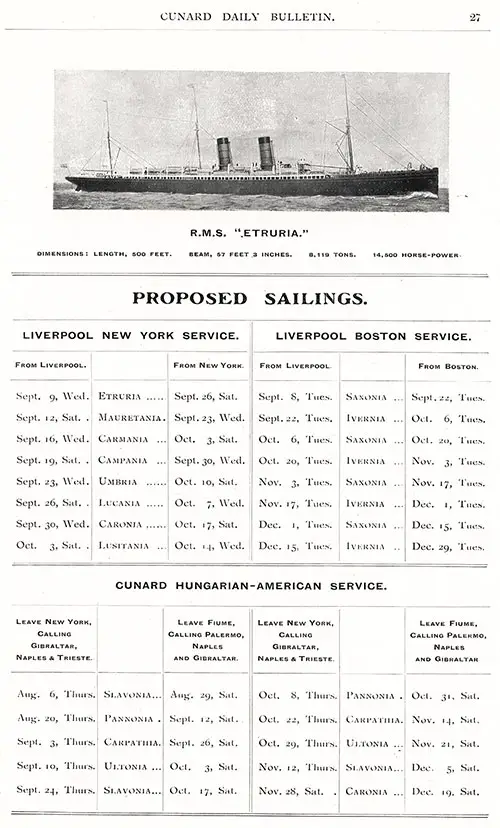
Sailing Schedule, Liverpool-New York, Liverpool-Boston, New York-Gibraltar-Naples-Trieste-Fiume, Fiume, Palermo-Naples-Gibraltar-New York, from 9 September 1908 to 29 December 1908. Ships Included the Campania, Carmania, Caronia, Carpathia, Etruria, Lucania, Lusitania, Mauretania, Pannonia, Slavonia, Ultonia, and Umbria. Cunard Daily Bulletin, 11 September 1908, Etruria Edition. | GGA Image ID # 1f031656fa

Proposed Sailings, Liverpool-Boston Service, Liverpool-New York Service, and Hungarian-American Service Covering 18 May 1909 to 11 September 1909. Ships Include the Campania, Carmania, Caronia, Carpathia, Ivernia, Lucania, Lusitania, Mauretania, Pannonia, Saxonia, Slavonia, and Ultonia. It also contains the Cunard Atlantic Fleet List. RMS Ivernia Passenger List, 18 May 1909. | GGA Image ID # 1dc96786d6

Sailing Schedule for the Quadruple-Screw Turbine Steamers "Lusitania" and "Mauretania," The Largest, Fastest, and Most Sumptuously Appointed Vessels in the World, July-October 1909. Insert in a Saloon Class Passenger List of the RMS Saxonia From 27 July 1909. | GGA Image ID # 159e71e3c2
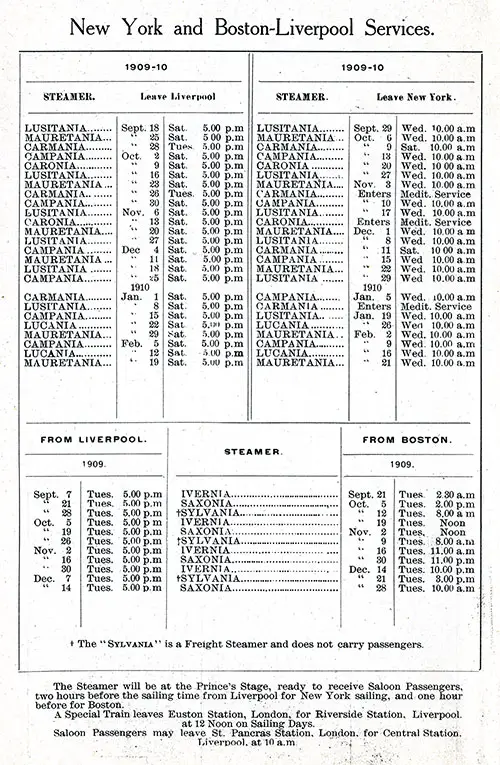
Sailing Schedule, New York and Boston-Liverpool, from 7 September 1909 to 21 February 1910. Ships Included the Campania, Carmania, Caronia, Ivernia, Lusitania, Mauretania, and Saxonia. NOTE: The Sylvania is a Freight Steamer and Does Not Carry Passengers. RMS Mauretania Saloon Passenger List, 6 October 1909. | GGA Image ID # 20fa83835c

Sailing Schedule for the Four-Screw Turbine Steamers Lusitania and Mauretania, Liverpool-New York, and New York-Liverpool, from 18 September 1909 to 29 December 1929. Insert from the RMS Mauretania Saloon Passenger List, 6 October 1909. | GGA Image ID # 20fa16276f

Sailing Schedule, Liverpool-New York, 28 September 1910 to 21 January 1911. Ships Included the Lusitania and Mauretania. RMS Campania Passenger List, 24 September 1910. | GGA Image ID # 1ea09e73eb

Proposed Sailings, Liverpool-New York Service, Liverpool-Boston Service, and Hugarian-American Service from 23 March 1911. Ships Include the Campania, Carmania, Caronia, Carpathia, Franconia, Ivernia, Lusitania, Mauretania, Pannonia, Saxonia, and Ultonia. RMS Caronia Passenger List, 1 April 1911. | GGA Image ID # 1dc9aa5170

Sailing Schedule for the Quadruple-Screw Turbine Steamers RMS Lusitania and RMS Mauretania from 29 July 1911 to 1 November 1911. When the "Lusitania" and "Mauretania" Are Alongside the Prince's Landing Stage, Liverpool, Telephonic Communication Is Established with Local and Trunk Lines for the Convenience of Passengers Desirous of Using Same. No Charge Is Made for Local Calls, but the Usual Post Office Fees Are Charged for Trunk Calls. Published 14 July 1911. | GGA Image ID # 1db6f9d658

Cunard Liverpool-New York and Boston Services. Sailing Schedule from 18 July 1911 to 16 January 1912. Ships Include the Caronia, Mauretania, Lusitania, Carmania, Campania, Caronia, Franconia, Saxonia, and Ivernia. | GGA Image ID # 1db72eac98

Proposed Sailings, Liverpool-New York Service, Liverpool-Boston Service, and Hungarian-American Service from 2 March 1912 to 6 August 1912. Ships Include the Campania, Carmania, Caronia, Carpathia, Franconia, Ivernia, Laconia, Lusitania, Mauretania, Pannonia, and Saxonia. RMS Caronia Passenger List, 30 March 1912. | GGA Image ID # 1dc9e8927c
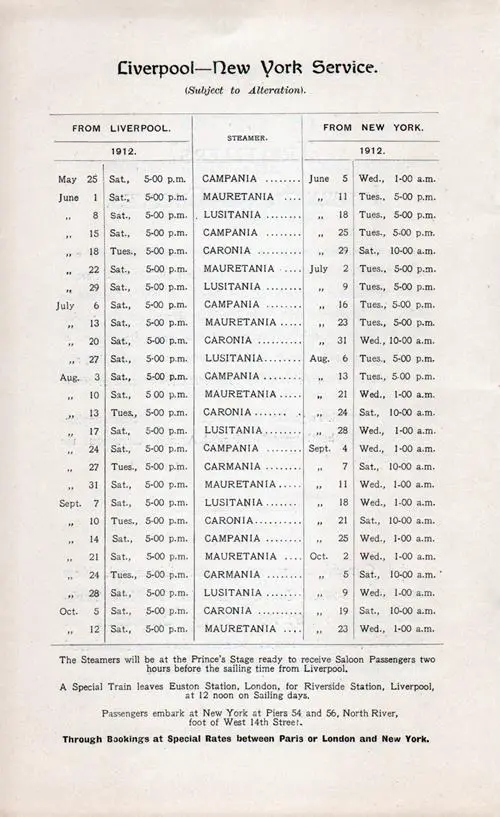
Cunard Liverpool-New York Service Sailing Schedule from 25 May 1912 to 23 October 1912. Ships Include the Campania, Caronia, Mauretania, and Lusitania. | GGA Image ID # 1dbbde659c

Proposed Sailings Liverpool-New York Service, Liverpool-Boston Service, and Hungarian-American Service from 9 November 1912 to 11 March 1913. Ships Include Campania, Carmania, Caronia, Carpathia, Franconia, Ivernia, Laconia, Lusitania, Mauretania, Pannonia, Saxonia, and Ultonia. SS Carmania Passenger List, 23 November 1912. | GGA Image ID # 1dc95f6c98

Cunard Liverpool-New York Service from 6 September 1913 to 7 February 1914. Ships Included the Campania, Carmania, Caronia, Ivernia, Lusitania, and Mauretania. RMS Carmania Passenger List, 23 September 1913. | GGA Image ID # 1dcaadfa74

Sailing Schedule, Southampton-Cherbourg-New York, from 12 August 1922 to 7 November 1922. Ships Included the Aquitania, Berengaria, Caronia, Mauretania, and Saxonia. RMS Laconia Passenger List, 24 August 1922. | GGA Image ID # 1e9b0b592b

Sailing Schedule, Southampton-Cherbourg-New York, from 8 September 1923 to 25 March 1924. Ships Included the Aquitania, Berengaria, Laconia, Mauretania, Saxonia, and Tyrrhenia. RMS Berengaria Passenger List, 15 September 1923. | GGA Image ID # 20aa911fd7

Sailing Schedule, Southampton-Cherbourg-New York, from 13 October 1923 to 25 March 1924. Ships Included the Albania, Andania, Antonia, Aquitania, Ausonia, Berengaria, Laconia, Mauretania, Saxonia, and Tyrrhenia. RMS Samaria Passenger List, 22 October 1923. | GGA Image ID # 1f19fa1211

Eastbound Sailing Schedule from the US and Canadian Ports to European Ports, from 18 June 1924 to 3 September 1924. Ships Included the Albania, Andania, Antonia, Aquitania, Assyria, Athenia, Ausonia, Berengaria, California, Cameronia, Carmania, Caronia, Cassandra, Columbia, Franconia, Laconia, Lancastria, Mauretania, Samaria, Saturnia, Saxonia, Scythia, and Tuscania. RMS Aquitania Second Class Passenger List, 18 June 1924. | GGA Image ID # 20aea275f3

Westbound Sailing Schedule, from European Ports to Canadian and US Ports, from 19 June 1924 to 26 August 1924. Ships Included the Albania, Andania, Antonia, Aquitania, Assyria, Athenia, Ausonia, Berengaria, California, Cameronia, Carmania, Caronia, Cassandra, Columbia, Franconia, Laconia, Lancastria, Mauretania, Samaria, Saturnia, Saxonia, Scythia, and Tuscania. RMS Aquitania Second Class Passenger List, 18 June 1924. | GGA Image ID # 20aeac371f

Sailing Schedule, Southampton-Cherbourg-New York, from 3 May 1925 to 8 October 1925. Ships Included the Albania, Aquitania, Berengaria, Lancastria, Mauretania, Saxonia, and Scythia. RMS Berengaria Passenger List, 24 May 1925. | GGA Image ID # 20ab1b7a1d
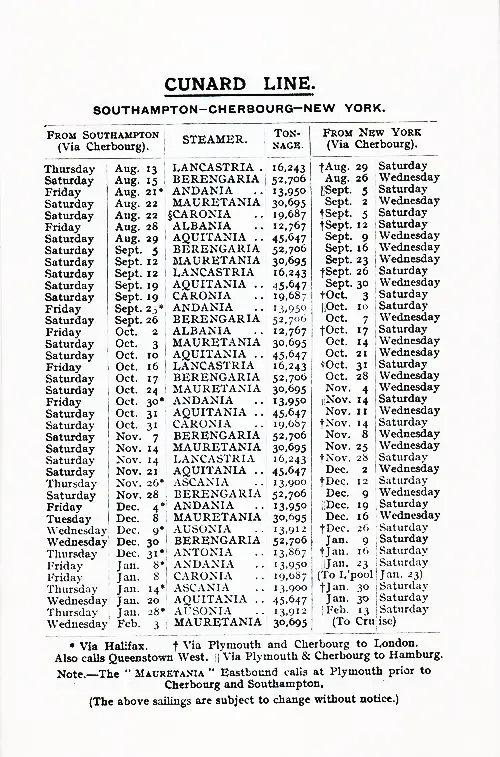
Proposed Sailings, Cunard Line, Southampton-Cherbourg-New York, from 13 August 1925 to 3 February 1926. Ships Included the Albania, Andania, Aquitania, Ascania, Ausonia, Berengaria, Caronia, Lancastria, and Mauretania. RMS Alaunia Passenger List, 21 August 1925. | GGA Image ID # 1dfef4697b
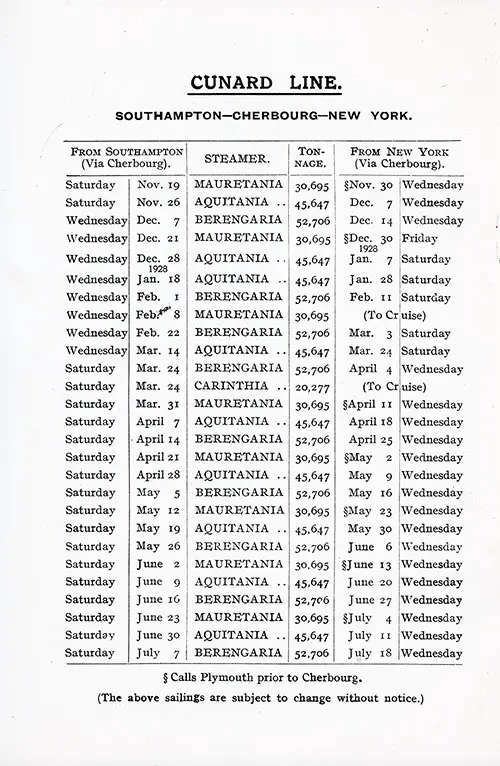
Sailing Schedule, Southampton-Cherbourg-New York, from 19 November 1927 to 7 July 1928. Ships Included the Aquitania, Berengaria, Carinthia, and Mauretania. RMS Aquitania Passenger List, 26 November 1927. | GGA Image ID # 1e111c01c6

Sailing Schedule, Southampton-Cherbourg-New York, from 21 April 1928 to 7 November 1928. Ships Included the Aquitania, Berengaria, and Mauretania. RMS Ausonia Cabin Passenger List, 4 May 1928. | GGA Image ID # 20a6348c6d

Sailing Schedule, Southampton-Cherbourg-New York, from 15 September 1928 to 29 May 1929. Ships Included the Aquitania, Berengaria, Carinthia, and Mauretania. RMS Ausonia Cabin Passenger List from 29 September 1928. | GGA Image ID # 20a896b0cf
Return to Content Links

Cunard Line Atlantic Services and Fleet List with Tonnage and Assigned Commanders, 1911. Ships Included the Albania, Aquitania, Ascania, Ausonia, Campania, Carmania, Caronia, Carpathia, Franconia, Ivernia, Laconia, Lusitania, Mauretania, Pannonia, Saxonia, and Ultonia. RMS Franconia Passenger List, 8 August 1911. | GGA Image ID # 1e8030fb50

Cunard Line Atlantic Services and Fleet List with Tonnage and Assigned Commanders, 1912. Ships Include the Alaunia, Albania, Andania, Aquitania, Ascania, Ausonia, Campania, Carmania, Caronia, Carpathia, Franconia, Ivernia, Laconia, Lusitania, Mauretania, Pannonia, Saxonia, and Ultonia. RMS Caronia Passenger List, 30 March 1912. | GGA Image ID # 1dc9ece700
Return to Content Links

Advertisement: Cunard Anchor Lines, Power, Stability, Comfort, Luxury in 1923 -- The New 20,000 Ton Cunarders Scythia, Laconia, Samaria, Franconia, and the Anchor Liners Cameronia and Tuscania. These Steamers--Running in Conjuction with the Renowned Caronia and Carmania--Offer Travel Opportunites Unexcelled in the History of Shipping. The World's Fastest Passenger Service, Weekly to Cherbourg and Southampton by the Aquitania, Mauretania, and Berengaria. Ocean Records, May 1923. | GGA Image ID # 1e687406f0
Return to Content Links
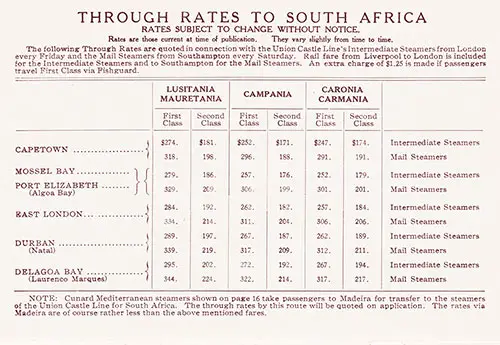
Through Rates to South Africa, First and Second Class. Ships Included the Lusitania, Mauretania, Campania, Caronia, and Carmania. Cunard Line Services 1914 Brochure. | GGA Image ID # 1f790261ed
Rates Subject to Change Without Notice. Rates Are Those Current at Time of Publication. They Vary Slightly from Time to Time. The Following: Through Rates Are Quoted in Connection with the Union Castle Line's Intermediate Steamers from London Every Friday and the Mail Steamers from Southampton Every Saturday. Rail Fare from Liverpool to London Is Included for the Intermediate Steamers and to Southampton for the Mail Steamers. An Extra Charge of $1.25 Is Made if Passengers Travel First Class via Fishguard.
NOTE: Cunard Mediterranean steamers shown on page 16 take passengers to Madeira for transfer to the steamers of the Union Castle Line for South Africa. The through rates by this route will be quoted on application. The rates via Madeira are of course rather less than the above mentioned fares.

Through Rates to South America, First and Second Class, One Way (Single) or Round Trip (Return). Ships Included the Lusitania, Mauretania, Campania, Caronia, and Carmania. Cunard Line Services 1914 Brochure. | GGA Image ID # 1f7935065b
RATES SUBJECT TO CHANGE WITHOUT NOTICE. Rates are those current at the time of publication. They vary slightly from time to time. The following Through Rates are quoted in connection with the Royal Mail Steam Packet Co. from Southampton, the Pacific Steam Navigation and Lamport & Holt Lines from Liverpool, and the Nelson Line from Liverpool and London—rail Fare to Southampton at Passenger's expense. The through fare covers rail fare to London via Liverpool for Nelson Line. However, $1.25 extra is charged if the passenger travels First Class via Fishguard.

Minimum Rates of Passage, First Class, Second Cabin, or Third Class. Ships Included the Aquitania, Lusitania, Maruetania, Campania, Caronia, Carmania, Franconia, Laconia, Ivernia, Saxonia, Andania, Alaunia, Ascania, Ultonia, Ausonia, Carpathia, and Pannonia. Cunard Line Services 1914 Brochure. | GGA Image ID # 1f7949ddf9
Sailing Schedule, New York - Liverpool Service, from 7 April 1914 to 6 January 1915. Ships Included the Aquitania, Campania, Carmania, Caronia, Franconia, Laconia, Lusitania, and Mauretania. Cunard Line Services 1914 Broncure. | GGA Image ID # 1f79a02dae. Click for Larger Image.
Return to Content Links

The First Great Ocean Liners in Photographs 1897 - 1927
Sumptuous volume recalls the glorious early years of elegant transatlantic travel. Over 190 historic photographs depict exterior and interior views of 101 great ocean liners, including the Virginian, Imperator, Vaterland, Bismarck, Lusitania, Mauretania, Balmoral Castle, Titanic, Olympic, Aquitania and dozens more. Full captions.

The book profiles the opulent lifestyles aboard such floating palaces as Normandie, Rex, Olympic, Amerika, Queen Mary, France, Mauritania, Queen Elizabeth II, Imperator, and Titanic. "Perhaps the most readable book on the subject ever to have appeared" --Country Life. Black-and-white photographs.

Picture History of the Cunard Line 1840 - 1990
Magnificent pictorial tribute to the long line of illustrious ships that sailed for one of the world's great shipping companies. Extensive fact-filled text, captions and over 180 photographs and illustrations recall the Britannia, Lusitania, Mauretania, Queen Elizabeth, Queen Mary and the QE2, among many others. Introduction.

Distinguished Liners from The Shipbuilder - 1906-1914 Volume 1
An authentic replication to the smallest detail of the best of The Shipbuilder magazine, 1906-1914, including articles on the Titanic, Olympic, Lusitania, Mauretania, and more. This encyclopedic collection contains original text, photographs, and advertisements, as well as 22 fold-out blueprint plans, five color plates, a two-color Titanic cutaway folding advertisement and even two facsimile subscription forms.
Return to Content Links
Information for Passengers - 30 March 1912
With the view of enabling passengers to reach London on Monday afternoon and Paris the same evening or following morning, the "Lusitania" and "Mauretania" have been scheduled to leave the New York Pier at 1 am on Wednesdays and proceed direct to Fishguard without calling at Queenstown. The steamers will thus be due at Fishguard on Monday morning.
Source: RMS Caronia Passenger List - 30 March 1912
Information for Passengers - 11 April 1908
Meals will be served in the Saloon at the following times:—
- Breakfast, from 8:30 to 10;
- Luncheon at 1:00 pm;
- the usual Dinner will be served at 7 o'clock, but Passengers who wish to dine at 7:30 or 8 o'clock may arrange parties and order specially prepared Dinner as desired from the Head Waiter, not later than 2 o'clock
- Supper, if required, must be ordered before 10 o'clock
The Bar will be closed at 11:30 pm and the Smoking Room at Midnight.
The Second Steward has the arrangement of the seats at table.
Divine Service on Sunday at 10:30 am
All enquiries regarding Baggage should be addressed to the Baggage Master.
Steamer Chairs may be hired from the Deck Steward at a cost of 4s. for the voyage.
The Company is not responsible for theft if valuables or money are kept in the Staterooms. The same should be placed in charge of the Purser for deposit in his safe, and a receipt will be given on the Company's form. As no charge is made for carriage the Company can not accept any responsibility for loss or damage, however arising, but Passengers can protect themselves by insurance.
Passengers should obtain a receipt on the Company's form for any additional Passage Money or Freight paid on board.
The Purser is authorized to exchange money at the following rates. He will give American money for English at $4.80 to the pound sterling and English money for U.S. Currency at £1 sterling for $4.95.
The Surgeon is authorized to make customary charges, subject to the approval of the Commander, for treating any Passengers at their request for any illness not originating on board the ship. In the case of sickness contracted on board no charge will be made and medicine will be provided free.
Passengers are notified that dogs cannot be landed in Great Britain unless a license has previously been procured from the Board of Agriculture, London. Forms of license must be obtained by direct application to the Department before the dog is taken on board.
The " Mauretania " carries an orchestra of highly-trained musicians, which will play at the undermentioned times and places :—
- Second Class Dining Saloon : 10:00 to 11:00 am
- First Class Dining Saloon : 1:00 to 2:10:00 pm
- Second Class Dining Saloon : 9:30 to 4:00 p.m
- First Class Dining Saloon : 7:10 to 8:45:00 pm
- First Class Drawing Room : 9:00 to 10:00 pm
This arrangement may be altered as circumstances necessitate.
A Stenographer and Typist is on board for the convenience of Passengers.
This Steamer is Fitted with Marconi's System of Wireless Telegraphy, Also with The Submarine Signalling Apparatus.
Source: RMS Mauretania Passenger List - 11 April 1908
Information for Passengers - 30 April 1921
MEALS will be served in the Saloon at the following times: —
- Breakfast, from 8 to 10.
- Luncheon, 1 to 2:00 pm
- Dinner, from 7:00 pm to 9:00 pm
The Bars will not be open later than 11:30 pm, but it is within the discretion of the Commander to close them during the voyage at any time should he consider this course desirable.
SEATS AT TABLE.—Application may be made at any of the Chief Offices in advance, or to the Second Steward on board the Steamer on day of sailing.
DIVINE SERVICE on Sunday at 10:30 am
CHAIRS AND RUGS may be hired at a cost of 7/6 or $1.50) each, on application to the Deck Steward. Each Rug is contained in a sealed cardboard box, and bears a serial number worked into the material so that passengers will have no difficulty in identifying their rugs. At the end of each voyage, the rugs which have been in use, are sent to the store and thoroughly cleaned, before being reissued.
VALUABLES,—The Company is not responsible for theft if valuables or money are kept in the Staterooms. The same should be placed in charge of the Purser for deposit in his safe, and a receipt will be given on the Company's form.
As no charge is made for carriage the Company car. not accept any responsibility for less or damage, however arising, but passengers can protect themselves by insurance.
PAYMENTS.—Passengers should obtain a receipt from the Purser on the Company's form for any additional Passage Money, Rugs. Chairs, Excess Baggage. Freight, etc., paid on board.
NOTICE.—Passengers are informed that Professional Gamblers are reported as frequently crossing on Atlantic Steamers, and are warned to take precautions accordingly.
THE SURGEON is authorized to make customary charges, subject to the approval of the Commander, for treating any passengers at their request for any illness not originating on board the ship. In the case of sickness contracted on board no charge will be made and medicine will be provided free.
LIBRARIES.— In addition to a library of standard literature "The Times" library of up-to-date books is available for the use of passengers.
ARRIVALS AT NEW YORK.—Passengers are landed at the Company's Piers, 53 to 56, North River, Foot of West I4th Street, where railway tickets can be purchased and baggage checked to any part of the United States and Canada. After landing, passengers should enquire at the desk on the wharf for letters and telegrams.
When any of the Company's steamers arrive at the Pier alter 8:00 pm, passengers have the option of remaining on board over night and landing after breakfast the following morning.
PUBLIC TELEPHONES.—Telephone service with booths and operator in attendance will be found near the Customs Lines on the New York Wharf.
TAXICABS AND CARRIAGES can be hired at the New York Piers. Instructions should be given to the Purser in advance.
ARRIVALS AT CHERBOURG,—Under normal conditions passengers are landed by tender up to 10:00 pm, but if the ship arrives later they will disembark after breakfast next morning.
ARRIVALS AT SOUTHAMPTON—Passengers will be landed up to 8:00 pm If the ship berths later passengers will disembark next morning after breakfast.
A Special Train will be despatched to London (Waterloo Station) as soon as possible after landing, the journey occupying about 1.75 hours.
BANKING — FOREIGN MONEY EXCHANGE — The Cunard Steam Ship Co. Ltd. have arranged with the London Joint City and Midland Bank, Limited, to establish a Branch of their Bank on board the RMS " MAURETANIA."
The Office in question is situated on the starboard side of "A" Deck near the entrance to Saloon Lounge.
Passengers wishing to exchange money, or transact other banking business, will receive every facility and attention.
ARRIVALS AT LIVERPOOL—TIME OF LANDING PASSENGERS.—Under normal conditions when any of the Company's steamers arrive alongside the Liverpool Landing Stage after 8:00 pm it is optional for the passengers to go on shore that night In the event, however, of their remaining on board, they will be landed after breakfast the following morning either at the Stage or in dock as circumstances permit In the same way when the vessel reaches the river but does not come alongside the Stage, to prevent inconvenience and to meet emergencies, any passengers desirous of disembarking will, on arrival of the steamer, be landed, with hand baggage only, by tender.
DOGS—Passengers are notified that dogs cannot be landed in Great Britain unless a license has previously been procured from the Board of Agriculture, London. Forms of license must be obtained by direct application to the Department before the dog is taken on board. Dogs are carried at owner's risk, rate being from £3 upwards, payable to the Purser.
CUSTOMS—Tobacco, cigars, etc., wines, spirits and perfumery are subject to duty on being brought into the United Kingdom, and the smallest quantities should be declared to the Customs Authorities. When required, reprints of copyright Books and music will be confiscated.
BERTHING OF PASSENGERS.—No alterations can be made except officially through the Purser.
BERTH LADDERS.—These may be obtained on application to Steward or Stewardess.
The "MAURITANIA" carries an orchestra of professional musicians, which will play at the undermentioned times and places:
- 10 00 to 11 00 am Second Class Dining Saloon
- 1 00 to 2-10:00 pm First Class Dining Saloon
- 3 30 to 4 00 p m. Second Class Dining Saloon
- 7 10 to 8 45 p m First Class Dining Saloon
- 9:00 to 10:00 pm First Class Drawing Room
DISEMBARKATION OF PASSENGERS AT CHERBOURG
Hand-baggage is carried from the steamer to the tender by the stewards. Passengers informed that from the time their hand-baggage is on the tender, they are solely responsible for it, and they must see that it Is passed through the Customs and placed on the special train in their carriage.
All hand-baggage not claimed on the tender or kit in the Customs Is collected and included with registered baggage for Paris. For these packages there Is a charge of Fcs. 20.00 per package, Cherbourg—Paris.
Passengers are advised that the Cunard Company cannot be held responsible for any loss or damage caused by neglect on the part of passengers not claiming their handbaggage on the tender.
All baggage registered in New York for Cherbourg only. If not claimed at the port is forwarded direct to Paris, a charge of Fcs. 20.00 per package being made irrespective of size or weight (Heavy nailed case or bulky packages will be charged as freight).
TICKETS—All passengers without rail tickets can obtain them from the Company's Office in the waiting room, at Cherbourg, which they pass through after clearing through Customs.
Source: RMS Mauretania Passenger List - 30 April 1921
Information for Passengers - 26 September 1928
Cunarder Magazine—The Company publishes at New York a monthly magazine devoted to travel and known as “The Cunarder." Copies may be obtained from the Library Steward. Annual subscription. one dollar. Subscriptions should be addressed to the Company’s office, 25 Broadway. New York.
"Drive Your Own Car in Europe"—Passengers' automobiles can be carried in Cunard ships at reasonable rates. The Company will handle all details, including crating, duties, customs, permits, plates, licenses, foreign club dues, maps, etc. A booklet giving all the particulars of this service may be obtained from the Purser or at any Cunard office.
Cunard Travelers’ Cheques are payable throughout the world and are honored by hotels, banks, and stores in payment of accounts. Owing to the system of signing and countersigning with the purchaser's signature, the checks, if lost, are valueless to whoever may find them Neatly bound in a wallet in denominations of $5, $10. $20, $50 and $100. they constitute, from the point of view of convenience and safety, an ideal method of carrying funds.
Tourist Department—A Department is maintained at the Cunard Company’s Offices where accurate information and helpful assistance relative to travel throughout the world is at the disposal of patrons.
Cruises in season are offered to the West Indies. Pacific Coast, South America, 'Round the World, etc.
Through Bookings to the Near bast, India, Australasia, the Fai bast. South America and South Africa can be arranged for passengers traveling via the Cunard Line to England or the Continent, there connecting with Steamers of other lines. Particulars and rates will he gladly quoted at any of the Company's offices.
Note:—-Passengers who have not paid the Head Tax, in consequence of their holding return tickets or being in transit to points outside the United States, will kindly complete Form 514 which they will receive from the Immigration Officials at New York, and forward tame to the Cunard Line. 25 Broadway. New York, as soon as possible after departure from the United States, or hand to the Purser of the steamer in which they return to the United Kingdom or Furope.
Wardrobe Trunks—The attention of passengers is called to the tact that the steamer has a baggage room where trunks may be stored during the voyage. It is not always possible to have targe wardrobe trunks placed in an accessible position in passenger staterooms.
Arrivals at Cherbourg—Under normal conditions passengers are landed by tender up to 10:00 pm. but if the ship arrives later they will disembark after breakfast next morning.
- In the event of passengers not being able to land sufficiently early to reach Paris before the following morning, there is a comfortable hotel. The Casino, which can accommodate any one who wishes to stay overnight at Cherbourg, and travel to Paris during the daytime. The Purser can arrange reservations by wireless.
- Passengers disembarking at Cherbourg, who intend traveling beyond Paris, are particularly requested to see that their baggage is appropriately labeled for destination. Under no circumstances should "Paris" labels be placed on such baggage as delay in forwarding as well as loss may result therefrom.
- Passengers who are traveling to European States east of France, who may have already secured their ticket for sleeping cars, trains de luxe or express trains from Paris onward, are reminded that their heavy baggage, which is checked to Paris, should be passed through the Customs at Cherbourg. This will avoid any possible inconvenience in making connections from Paris, as on arrival at the Gare St. Lazare in Paris, they can obtain their baggage with a minimum of delay
- The Cunard Company maintains porter service at Cherbourg to facilitate the handling of passengers' baggage. The transfer of baggage from the steamer to the train is free of charge, passengers are not obliged to pay, or give gratuities, for this service.
- Hand baggage is carried from the steamer to the tender by the stewards. Passengers are informed that from the time their hand-baggage is on the tender, they are solely responsible for it. and they must see that it is passed through the Customs and placed on the special train in their carnage.
- All hand-baggage not claimed on the tender or left in the customs is forwarded free of charge to Paris.
- Passengers are advised that the Cunard Company cannot be held responsible for any loss or damage caused by neglect on the part of the passengers not claiming their hand-baggage on the tender. All baggage registered in New York for Cherbourg, if not claimed at the port, is forwaidcd direct to Paris at a charge of 40 francs per package from Cherbourg irrespective of size or weight. Heavy, nailed cases or bulky packages will be charged as freight.
Arrivals at Plymouth—From May 1st to September 10th passengers are landed between the hours of 6 a m. and 9:00 pm
From October 1st to April 30th passengers are landed between 7:00 am and 9:00 pm
Arrivals at London—The Great Western Railway will run special trains from Plymouth Docks to London (Paddington Station) immediately passengers are landed and the baggage examined by the British Customs Authorities. The journey to London occupies four hours.
Arrivals at Southampton—Passengers will be landed np to 8:00 pm If the ship berths later, passengers will disembark next morning after breakfast.
In connection with the arrivals of the Berengaria and Aquitania only, a special train will be despatched to London (Waterloo Station) as soon as possible after landing: the journey occupying about 1 3/4 hours. Passengers wishing to travel First Class on the special trains, are recommended to purchase their Rail Tickets at the Purser's Office.
Passengers are informed that the Cunard Company employs at Southampton the necessary labor for transfer of baggage from the steamer to the special trains at the ship's side for London.
Passengers on arrival will find representatives of well-known firms in the shed alongside the steamer and if their special services are utilized for the handling of luggage they are authorized to charge according to tariff.
Port of Liverpool—Under normal conditions when any of the Company's steamers arrive alongside the Liverpool Landing Stage after 7:00 pm, it is optional for the passengers to go on shore that night. In the event, however, of their remaining on board, they will be landed after breakfast the following morning either at the Stage or in dock as circumstances permit.
in the same way when the vessel reaches the river, but does not come alongside the Stage, to prevent inconvenience and to meet emergencies, any passengers desirous of disembarking will, on arrival of the steamer, be landed, with hand-baggage only, by tender.
Air Service—Seats can be arranged for Aeroplane Services from London or Manchester to Amsterdam, Rotterdam, Paris, Brussels, Berlin, etc., also from Cherbourg to Paris. Applications should be made to the Purser.
Source: RMS Mauretania Passenger List - 26 September 1928
Return to Content Links

Back Cover of a Saloon Passenger List for the RMS Mauretania of the Cunard Line, Departing Saturday, 11 April 1908 from Liverpool to New York. | GGA Image ID # 159db4e679

The Mauretania Is the Mercury among Ships, Holding Numerous World-Records for Speed. Her Latest Transatlantic Record Is 4 Days, 23 Hours, 13 Minutes, from New York to Plymouth. Like the Other Two of the Cunard "Big Three," the Mauretania Runs from New York to Southampton via Cherbourg. Going Abroad, 1923. | GGA Image ID # 1bc2f5b72d
No recent event in the shipping world has excited nearly so much general interest as the completion and entry upon the Atlantic service of the two new express Cunarders, the Lusitania and Mauretania.
The performances of both vessels have demonstrated that Britain possesses two ships capable of beating all Atlantic records in them but that their superiority in speed is so great that it is not likely to be challenged for many years to come. This success is a crowning tribute to the enterprise which has distinguished the Cunard Line from its inception sixty-seven years ago to the present time.
The Mauretania and her Sister Ship Lusitania are the outcomes of an agreement made between the British Government and the Cunard Steamship Company. They contracted to produce two steamships " capable of maintaining a minimum average ocean speed of 24 to 25 knots an hour in moderate weather."
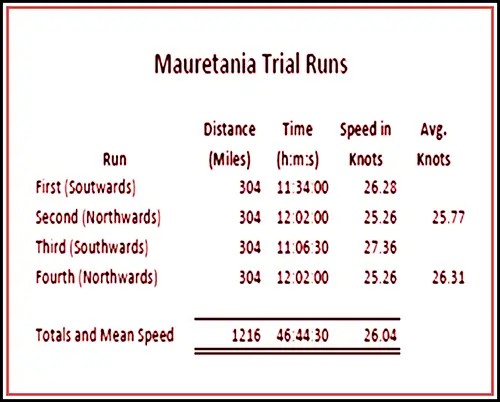
Table I: Trial Speed Runs for the New Cunard Liner Mauretania. Engineering Magazine, 8 November 1907. | GGA Image ID # 1bae59cb44
Return to Content Links
- Built by: Swan, Hunter & Wigham Richardson, Ltd., Wallsend-on-Tyne, Newcastle, England.
- Designer: Leonard Peskett
- Owner: The Cunard Steamship Company, Limited.
- Tonnage: 30,696
- Funnels: Two masts and four funnels
- Dimensions: 762' long x 88' wide (790' Overall Length).
- Port of Registry: Liverpool (Southampton after 1921)
- Propulsion: Quadruple-screw, 26 knots. Four steam turbines.
- Launched: September 20, 1906
- Office Registry Number: 124093
- Passengers: 563 first-class, 464 second-class, 1,138 third-class.
- Maiden voyage: Liverpool-New York, November 16, 1907.
- Speed Records: Held the trans-Atlantic speed record, along with her sister ship for several years.
- Eastbound Crossing Speed Record: In June 1909, she made the eastward crossing in 4 days, 17 hours, and 21 minutes.
- Horsepower: Rated at 68,000 shaft horsepower. (90,000 horsepower after conversion to oil) Equipped with 23 double and two single-ended boilers working at 200 lb. pressure.
- Westbound Crossing: In September 1928, she made the Cherbourg to Ambrose Light crossing in 5 days, 2 hours, and 34 minutes, a remarkable feat for a twenty-two-year-old liner, especially as she was at the time equipped with her original "Parson's" steam turbines.
- Fate: The grand old ship was finally broken up by shipbreakers at Rosyth in July 1935, thus ending the career of one of the most famous and successful Atlantic liners.
- World's Largest Ship: She was the world's largest ship until the White Star Line RMS Olympic launch in 1910.
- Sister ship: Lusitania.
- Fuel: Coal. It was converted to Burn Oil in 1921 at Swan, Hunter & Wigham Richardson, Ltd.
- Nicknames: "Maury" and "Grand Old Lady of the Atlantic."
- Blue Riband Speed Records: Westbound Record 1909-1929; Eastbound Record 1907-1929
- Grand Old Lady: She held the Blue Riband of the Atlantic for 22 years, and in August 1929, when she was 22 years old, she made the fastest transatlantic passage of her career, crossing from New York to Plymouth at an average speed of 27.22 knots.
- Pleasure Cruising: Hull Painted White During Pleasure Cruising Period 1933.
Return to Content Links
Plate C:- Cross-Section of the Cunard Liner RMS "Mauretania." Engineering Magazine, 8 November 1907. | GGA Image ID # 1bb53551a7 -- Click to View Larger Image
The Quadruple-Screw Turbine-Driven Cunard Liner RMS Mauretania Elevation and Deck Plans. Constructed by Messrs. Swan, Hunter, and Wigham Richardson, Ltd., Wallsend-on-Tyne; Engined by the Wallsend Slipway and Engineering Company, Ltd. | GGA Image ID # 20d1feae60. Click to View Larger Image.
Return to Content Links
The Life of R.M.S. Mauretania by Blue Star Line, Graphics by Alex Beaut, 6 March 2020. YouTube Video Retrieved 2022-05-15.
Design and construction

Workers Leaving the Mauretania at Swan, Hunter & Wigham Richardson, Ltd., Wallsend-on-Tyne, Newcastle, England Shipbuilding Yard. The Shipbuilder, November 1907. | GGA Image ID # 1baba439cc
The conditions laid down in the agreement entered into in 1903 between the British Government and the Cunard Company required the construction of two steamships "capable of maintaining during a voyage across the Atlantic a minimum average speed of from 24 to 25 knots (say, 27 to 29 statute miles) per hour in moderate weather."
This stipulation, coupled with the large amount of passenger accommodation aimed at, the stringent requirements of the British Admiralty, and the determination of the owners to make the vessels much more robust than any other fast Atlantic vessel afloat and to introduce every known contrivance for the safety and comfort of the passengers, compelled the designers to adopt unprecedented dimensions.

Observation Tower or Bridge of the RMS Mauretania. The Brain of the Ship. The Navigating Bridge Shows the Various Control Devices and Wheel-House. All the Stone-Lloyd Watertight Doors Are Closed from This Point Simultaneously by the Pressure of a Lever. The Master, Mate and Pilot, June 1908. | GGA Image ID # 1bb47814ff
When one reads about these brilliant achievements of the Mauretania or sees her driving along at full speed, one never thinks about the infinitely laborious experiments and calculations involved before even her keel was laid.
A long list of men famous for their association with marine engineering problems—such experts as Sir William White, Sir E. J. Reed, the Honorable Sir Charles A. Parsons, Dr. Brum, Messrs. George B. Hunter, W. Johns, McQuorn Rankine, W., and R. E. Froude, together with the expert staff of the builders—contributed to her design.
Many varied factors must be considered in planning a particular type of vessel. There are questions of stability—one of the vital problems of the ship—speed, economy, and steadiness when traveling at full speed, not only in smooth but also in rough weather, which has to be threshed out thoroughly.

Plate LXVII Fig. 45:- Quadruple-Screw Turbine-Driven Cunard Liner Mauretania Ready to Launch. The Striking Illustration above Shows the Stern of the Mauretania Out of the Water, the Photograph Having Been Taken. At the Same Time, the Vessel Was Being Built at Wallsend-On-Tyne by Messrs. Swan, Hunter, and Wigham Richardson. It Will Be Noticed That There Are Two Propellers on either Side of the Rudder. The Two Outermost Are Driven by the High-Pressure and the inside Two by the Low-Pressure Turbines. The Two Inner Propellers Are Also Used for Going Astern, and since the Turbine Can Only Turn In One Direction, These Two Are Each Fitted with a High-Pressure Turbine. When the Ship Is Steaming Ahead, These Astern Turbines Revolve Idly. Engineering Magazine, 8 November 1907. | GGA Image ID # 1bb4db0801

Plate LXX Fig. 47:- The Mauretania in the Fitting-Out Berth at the Wallsend Shipyard. Engineering Magazine, 8 November 1907. | GGA Image ID # 1bb4fd0247
For instance, to give an idea of the wind forces and their influences on speed, power, etc., to enable the Mauretania to maintain a speed of 25 knots per hour against a headwind blowing at an equal velocity, it was calculated that 12 percent more power would be required than to uphold the same speed in calm weather.
On the other hand, with the following wind of identical velocity, the liner could notch 25 knots with about 4 percent less power than in calm weather.
It is doubtful whether the construction of any vessel in merchant marine history has ever been attended by such exhaustive preliminary work to reduce the element of chance to its most infinitesimal proportions.

The "Mauretania" Leaves the Tyne for the Mersey. The New Cunarder, Mauretania, Which Is the Sister Ship of the Record-Breaking Lusitania, Left the Tyne on Monday for Liverpool with 500 Guests, Including Lord Brassey on Board. She Is a Magnificent Vessel. The Sphere, 26 October 1907. | GGA Image ID # 1bb3d0e08d
The passenger accommodation of the Mauretania, when its spaciousness and beauty of decoration are taken into account, certainly justifies the use of the somewhat extravagant term "a floating palace." It is claimed that the vessel offers 50 percent more light and air space and deck promenade per passenger than any other liner afloat except for the Lusitania.

Plate LXXIII Fig. 65:- First Class Dining Saloons, Upper and Lower Levels Showing Dome on the RMS Mauretania. Engineering Magazine, November 1907. | GGA Image ID # 1bac2f0011
Saloon Accommodation
- Main Saloon Dining Room. Situated amidships on "D" Deck.
- Upper Dining Saloon. On "C" Deck," approached from the main staircase.
- Lounge and Music Room. Amidships On "A" Deck with entrance from promenade deck, elevators, or main staircase.
- Writing Room and Library. Forward of the lounge on "A" Deck with entrance from promenade deck, elevators, or main staircase.
- Smoking Room. This is situated astern of the lounge on "A" Deck with entrance from the lounge and can also be entered either from the promenade decks or by staircase.
- Verandah Café. Astern of the Smoking Room, on "A" Deck.
- Staterooms. Situated on Boat, "A," "B," "D," and "E" Decks.
- En Suite Rooms. Regal and Parlor Suites. These rooms are situated on both sides of " A " and " B " Decks.
- Children's Room. On "C" Deck, just forward of the upper dining saloon.
- Purser's Bureau. Situated off the reception room on "B" Deck. Here passengers should deposit valuables, etc., for safekeeping. The Company is not responsible for theft if valuables or money are kept in the staterooms. They should be placed in the Purser's safe, and a receipt obtained on the Company's form. However, the Company cannot accept any responsibility for loss or damage, but passengers can protect themselves with insurance.
- Bank. For money exchange, etc., on " A " Deck.
- Chief Steward's Office. Adjacent to the main dining saloon on " C " Deck.
- Barber's Shop. On "B" Deck on starboard or right-hand side, astern of saloon accommodation. Open from 8:00 am.

Cabin Class Passenger Accommodations on the RMS Mauretania. Cunard Line Passenger Guide - Mauretania, 1921. | GGA Image ID # 1bb5d491b1

First Class Upper Dining Saloon and Dome on the Mauretania. The Decorations Are Carried Out in Carved Oak, in the Style of François Premier. One of the Charms of This Style Is That No Piece of Carving Is a Replica of Its Neighbors. The Shipbuilder, November 1907. | GGA Image ID # 1bac50ae57

Another View of the First-Class Upper Dining Saloon on the RMS Mauretania. Some of the Most Delicate Work Is Shown upon the Arched Bulkheads, Which Run at Right Angles to the Ship's Sides. The Designer Has Aimed to Keep the Larger and Lower Room Richer in Carving, Leading Up to a Simpler Treatment in the Upper Dining Saloon and Terminating with the Crowning Feature of the Lofty Groined Dome. In the Upper Saloon, Parties of 6 Persons Can Be Seated at Each Table. The Shipbuilder, November 1907. | GGA Image ID # 1bac7a5d68
The accommodation for first-class passengers placed amidships extends over five decks--the main, upper, shelter, promenade, and boat decks. Access from one deck to another is obtained utilizing the grand and other staircases and two separate electric passenger elevators, traveling from the main to the boat deck.
The shipbuilders have carried out the more significant part of the accommodation for passengers, officers, and crew in their workshops. This includes all the second-class public rooms, the first-class corridors, and most of the first-class staterooms.
Subcontractors have done the following work. The first-class lounge and library by Messrs. Ch. Mellier and Co., London; the first-class dining- rooms, smoking room, grand entrances, 54 unique staterooms, and the Regal Suites by Messrs. Turner, Lord, and Co., London; the children's room and 16 unique staterooms by Messrs. Robson and Sons, Newcastle-on-Tyne.

A Bay in the First Class Lounge on the RMS Mauretania. The Shipbuilder, November 1907. | GGA Image ID # 1bac7bb9e8

Another View of the First-Class Lounge on the RMS Mauretania, 1907. Altogether, the Lounge Gives a Beautiful Impression of Quiet Grandeur, with Its Panels of Beautifully Grained Mahogany, Dully Polished a Rich Brown, Each Lit by Its Surrounding Molding of Gold, and Relieved by Slender Pilasters of Fleur de Pêcher Marble of a Lilac Hue, with Caps and Plinths of Somber Ormolu. The Mantelpiece, of the Same Materials, is a Work of Art and Accentuates the Feeling That One Is in Some Grand Palace of a past Age. The Shipbuilder, November 1907. | GGA Image ID # 1bacc374df

First Class Library of the RMS Mauretania Looking Across the Ship, 1907. The Lounge and the Library Have Been Decorated So That upon Entering Them, One Is Transported in a Moment from the Cold Realities of a Modern Steamship to the Exquisite Taste of a French Salon of the Eighteenth Century. | GGA Image ID # 1bb3ceff47

First Class Library on the Mauretania Showing Bookcases, 1907. The Library Extends across the Deckhouse, Being 33 Ft. Long by 56 Ft. The Deckhouse Walls are Bowed Out to Form Bay Windows, Which Is an Improvement upon the Ordinary Flat Walls Characteristic of Ships. | GGA Image ID # 1bb3978a0d

First Class Smoking Room, Looking Forward on the Mauretania. The Smoking Room Opens Aft from the Grand Entrance on the Promenade Deck and Is Decorated Following the Ideas of the Late Georgian Period. The Upholstering of the Chairs and Sofa Seats Is in a Dark Blue Velvet-Pile Moquette. The Work Is Done in Mahogany, Inlaid with English Boxwood and Burr Mahogany. The Shipbuilder, November 1907. | GGA Image ID # 1bad1d6d21

First Class Smoking Room, Looking Aft on the Mauretania. The Smoking Room Is Aft on the Boat Deck and May Be Reached from the Deck or the Entrance Hall through the Music Saloon or Lounge. The Smoking Room Is All That Such a Room Should Be; It Is 53 Ft. Long and 50 Ft. Wide. The Roof Has Formed a Dome, Making the Veranda Bright and Attractive. It Is Decorated in the Italian Style of the 16TH Century and Is Again Remarkable for Its Hugeness. An Interesting Feature Is the Series of Cozy Corners with Divans and Card- Tables on Each Side of the Room and Portioned off by Handsome Open Screens. The Shipbuilder, November 1907. | GGA Image ID # 1bad4298bb
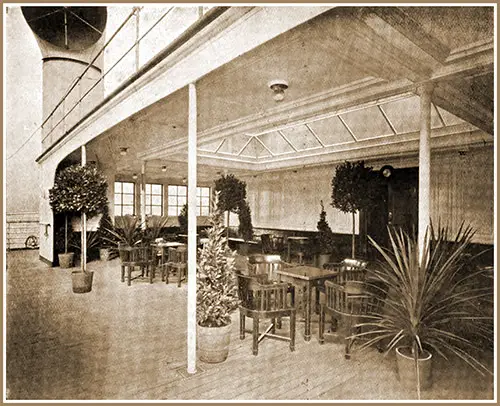
The Verandah Café on the Boat Deck - RMS Mauretania. The Provision of a Verandah Café at the End of the First-Class Smoking Room on the Boat Deck Is One of the Many Delightful Innovations of the Mauretania. Here Passengers May Sit and Sip Their Coffee in the Open Air, Perfectly Protected from the Weather. Evergreens Have Been Trained along the Glazed Roof, Giving the Passenger an Impression of Shore Comforts. The Furniture in the Verandah Café Has Been Supplied by Mr. J. P White of the Pyghtle Works, Bedford. The Shipbuilder, November 1907. | GGA Image ID # 1bad81155f

The RMS Mauretania Observation Room. This Apartment Is Situated on the Promenade Deck at the Fore-End of the Deckhouse. It Commands an Uninterrupted View over the Vessel's Bow While Affording Complete Protection from the Weather. Passengers Can Thus See the Ship Forging Ahead without Being Exposed to the Force of the Wind Caused by the Incredible Speed at Which the Vessel Travels. The Shipbuilder, November 1907. | GGA Image ID # 1bad887a45

The First-Class Children's Room on the RMS Mauretania. In the Children's Room., Which Is Situated on the Shelter Deck and Reached from the Grand Entrance, the Work Has Been Done in Mahogany, White Enameled. The Paneling on the Walls Is Decorated with Paintings by a Well-Known Artist Mr. J. K. Mitchell of New-Castle-On-Tyne, Illustrating the Nursery Rhyme "Four and Twenty Blackbirds." Dining Tables and Seats of Suitable Height for Little Passengers Are Provided; The Oversized Rocking Horse in the Center of the Room Will Undoubtedly Be Much in Demand. As in the Public Rooms Generally, the Windows in This Room Are Square and Not the Usual Circular Lights Used in Ship-Work. A Children's Lavatory and Pantry, Besides Rooms for Four Stewardesses and Two Matrons, Open off the Children's Room. The Shipbuilder, November 1907. | GGA Image ID # 1bada741bc
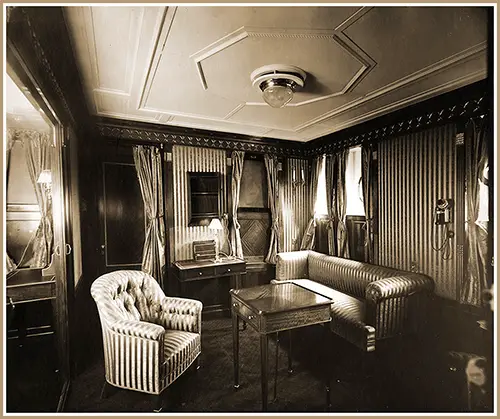
Regal Suite Parlor Drawing Room on the Mauretania. In This Part of the Promenade Deck, There Are Two Regal Suites on Port and Starboard. The Regal Suites, of Which There Are Two, Contain a Drawing-Room, Dining-Room, Two Bedrooms, a Bathroom, Pantry, and a Private Corridor. The First Two Rooms Are Divided by Wide Sliding Doors, so That They May Be Used as One Room if So Desired. The Telephone Instruments Are Fitted in the Regal Suite and First-Class Staterooms, as Shown above on the Wall to Your Right, and in the Cabins of the Ship's Doctor, Purser, Chief Steward, and Bureau. The Shipbuilder, November 1907. | GGA Image ID # 1badae9387

Parlor Room in an En Suite Stateroom on B Deck on the Mauretania. Along Each Side of the Main Deckhouse Are en Suite Rooms. On This Level, There Are Six Rooms with Single Berths, Sixty-Four with Two Berths, and Thirty-Two with Three Berths. The Shipbuilder, November 1907. | GGA Image ID # 1badbc9e6f

First Class Promenade on the Boat Deck, Looking Aft on the RMS Mauretania. The Boat Deck, Which Extends over the More Significant Part of the Ship's Center, Contains Some of the Finest en Suite Rooms. Abaft These, the First-Class Library, the Grand Entrance Hall, the First-Class Lounge and Music Room, and the First-Class Smoking Room Are at the Forward End. The Shipbuilder, November 1907. | GGA Image ID # 1bae57cc08
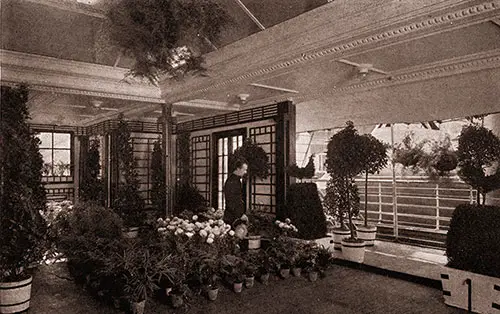
This Gay Glimpse of the Gardener's Corner on the Mauretania Shows Some of the Lovely Flowers That Brighten the Great Ship. Ivy and Clipped Privet, Ferns, and Dark Yews Make a Background of Rich Greenery for the Multicolored Blossoms Which Adorn the Record-Breaking Cunarder. Going Abroad, 1923. | GGA Image ID # 1bc2f65f0d
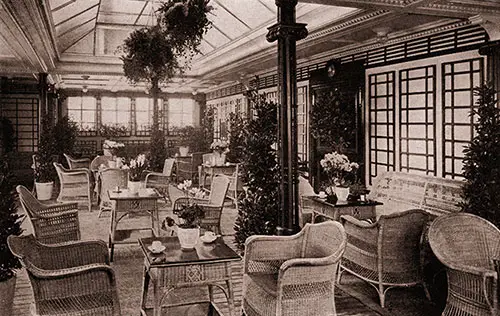
The Veranda Café on the Mauretania Is So Attractive, with Its Light Wicker Furniture, Its Flood of Sunlight, and Its Trailing Greenery, That You Would Think You Were on Some Country-Club Piazza. And Just outside Is the Sea, Changeful and Yet Tranquil, Ever-Alluring. Going Abroad, 1923. | GGA Image ID # 1bc3a7d5d7

In Its Eighteenth-Century Loveliness, the Lounge Is the High Light of Brilliance on the Mauretania. Here the Leisurely, Festive, Cosmopolitan Company Gathers to Hear the Ship's Orchestra Play, under the Crystal Lights; Or Merely to Chat under the Sunny Dome. Going Abroad, 1923. | GGA Image ID # 1bc3df5d34

The Mauretania Is a Typical Example of the Way in Which Cunard Staterooms Have Been Individualized So That They Are Now as Charmingly Fitted as Rooms in a Fine Hotel. Going Abroad, 1923. | GGA Image ID # 1bd1287e66

The Cold Buffet on the Mauretania, Garnished by the Deft Hand of the Chef, Provokes the Most Listless Appetites. Whole Sides of Roasted Meats, Meat Pies, Cold Game, and Fish Cunningly Decorated, Contribute to Its Attractiveness. Going Abroad, 1923. | GGA Image ID # 1bd06ab9b4
Second Class Accommodation
Location on the Mauretania
Dining Saloon. On the "D" Deck leading from the second-class main entrance.
Lounge. On "A" Deck situated to the stern of the steamer.
Drawing and Writing Room. On "B" Deck, main entrance.
Smoking Room. Also, on " B " Deck, but astern of the Drawing Room.
Barber's Shop. On "D" Deck off the right or starboard alleyway, astern of the dining saloon. Open from 8:00 am.
Staterooms. Situated on "C," " D," and "E" Decks.
The accommodation for second-class passengers, like the first-class, extends from the main to the boat decks, but it is further aft. The second-class staterooms are on the main, upper, and shelter decks, while the public rooms are on the promenade and boat decks.
Inspecting these apartments reveals that the second-class quarters are surpassed by the first-class accommodation in magnificence but not in comfort. In the general design and the treatment of detail, the same care has been exercised, and, indeed, a passenger coming on board for the first time might be excused for mistaking the second-class public rooms and staterooms for the first class.
Only a few years ago, one would have considered such accommodation worthy of first-class passengers. If one feature more than another will make the Mauretania popular with Atlantic travelers, it will be the beauty and comfort of this accommodation section. In catering to this class of passengers, the Cunard Company may claim to lead the way among the great steamship lines plying between the Old and the New Worlds.

Second Class Dining Room on the RMS Mauretania. The Second-Class Dining Saloon on the Upper Deck Opens Direct from the Grand Entrance and, as We Have Already Said, has a Length of 61 Ft., Is the Entire Width of the Ship, and Has a Height of 10 Ft. The Design Is Carried Out in Oak and Parquetry Flooring to Suit. Here Also, the Georgian Period Is Simulated in Furniture and Decoration. The Shipbuilder, November 1907. | GGA Image ID # 1badc1b250

Second Class Smoking Room on the Mauretania. The Smoking Room Is Aft on the Boat Deck and May Be Reached from the Deck or the Entrance Hall through the Music Saloon or Lounge. The Smoking Room Is All That Such a Room Should Be; It Is 53 Ft. Long and 50 Ft. Wide. There Is Formed on the Roof a Dome, Which Makes the Veranda Bright and Attractive. The Shipbuilder, November 1907. | GGA Image ID # 1badc58e0e

Second Class Lounge on the RMS Mauretania. The Second-Class Lounge Is Accommodated in the Deckhouse Aft on This Level and Forms the Entrance to the Second-Class Quarters. The Shipbuilder, November 1907. | GGA Image ID # 1badf0a581

Second Class Drawing and Writing Room on the Mauretania. Note the Upright Piano on the Far Left of the Photo. The Drawing-Room for the Second-Class Passengers Is on the "B" Deck, Opening from the Grand Entrance Forward. Here a Pleasing Effect Is Produced by Adopting Maple with Gold Decorations. The General Style Is of the Louis Seize Period. | GGA Image ID # 1bb2815d4c

Special Second-Class Stateroom on the RMS Mauretania. The Shipbuilder, November 1907. | GGA Image ID # 1badf5379f

RMS Mauretania Second Class Promenade on the Boat Deck, Looking Forward. There Is Splendid Promenading Space on This Boat Deck, and the Boats, if an Obstruction from Some Points of View, Affords Protection from Wind and Sun for Passengers on the Deck Chairs. The Shipbuilder, November 1907. | GGA Image ID # 1badffec7b
A well-known authority on steamship decoration who happened to enter the public rooms for the second-class passengers before reaching the saloons for the first-class passengers was surprised when told that he had not been in the principal rooms of the ship, so satisfactory did he consider these second-class rooms.
Return to Content Links
Third Class Accommodation
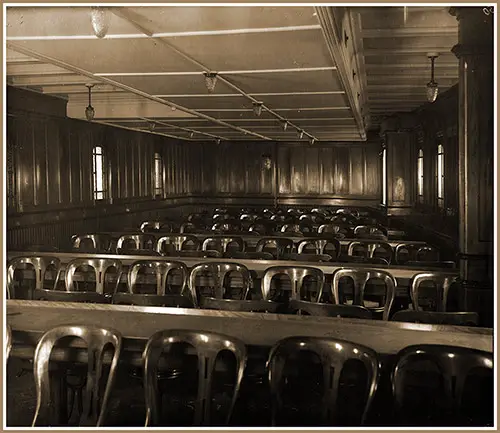
Third Class General Activity Room on the RMS Mauretania. | GGA Image ID # 1bb2e48eb2
The third-class accommodation is situated forward, on four decks—the lower, main, upper, and shelter decks. The sleeping accommodation is on the lower and main decks, and the public rooms are on the upper and shelter decks.
Two main staircases extend from the mam to the upper deck, one giving direct access to the dining saloon on the upper deck. This dining saloon is enormous, 84 feet long, and the entire ship's width.
The height of the apartment—10 feet—makes it both light and airy. Revolving chairs are provided, and 330 persons can be accommodated in one sitting.
The room is paneled in best-polished ash with teak moldings, and the floor is covered with Corticine. The sidelights are screened by sliding sashes fitted with colored obscure glass.
The builders' representatives strongly condemned using the word " Steerage" on the Mauretania. The correct designation is " Third Class, " and the rooms provided for this section of the traveling public are in keeping with the general luxury and comfort of the shin.
The bathrooms and lavatories are superior to most hotels in the provinces. The accommodation generally is relatively equal to what one finds in the first-class on some boats that ply between Venice and Trieste and other ports in the Adriatic Sea and the Mediterranean, as the writer can testify.
The public rooms for the third-class passengers are on the upper and shelter decks forward, and the sleeping accommodation is on the lower and main decks. Two main staircases extend from the main to the upper deck, one giving direct access to the dining saloon on the upper deck.
Table XI:- Summary of Passenger Accommodations on the RMS Mauretania. Engineering Magazine, 8 November 1907. | GGA Image ID # 1baf3171bb -- Click to View Larger Image.
Return to Content Links
Baths, Lavatories, Etc. On each deck are Ladies and Gentlemen's Baths and Lavatories. Arrangements should be made with a steward in charge of the use of the bath.
Doctor. The Consulting Room is on the "C" Deck leading off the main entrance. The Doctor is authorized to make customary charges, subject to the commander's approval, for treating any Passengers at their request for any illness not originating on board. In cases of sickness contracted on board, no charge will be made, and medicine will be provided free.
Library. A Library of classic books under the control of the Library Steward is at the disposal of passengers during the voyage. Current reviews, magazines, etc., are also placed on board.

The Kitchen of the RMS Mauretania. The Galleys, Pantries, Bakery, Confectionery Room, and Knife-Cleaning Room for the First-Class Accommodation Extend for 130 Ft. The Entire Width of the Ship. Situated on the Upper Deck between the First and Second-Class Dining Saloons, Convenient Service Is Ensured to Both. Travelling Palaces: Luxury in Passenger Steamships, 1913. | GGA Image ID # 1bb0d946aa
The Galleys
The galleys, pantries, bakery, confectionery room, and knife-cleaning room for the first-class accommodation extend for 130 feet, the entire width of the ship. It is claimed that they form the most extensive kitchen afloat. Situated on the upper deck between the first and second-class dining saloons, convenient service is ensured to both.

Cunard Passenger Fleet with Comparisons Showing Relative Size of Ships. | GGA Image ID # 118efdd844
Electricity plays a large part in the culinary operations onboard the vessel. The main cooking range, heated by a coal fire, is 24 feet long by 8 ft. wide. In addition, there are four large steam boilers, twelve steam ovens, three large electric grills, and various roasters driven by electric motors. The pantries have carving tables, bain marries, and electric plate-washers.

A View of a Kitchen on the RMS Mauretania. | GGA Image ID # 1bb1421220
There are numerous ovens in the baker's shop and an electrically driven dough -mixer. The confectionery room has a long marble lopper table, an ice cream machine, etc.
Four electrically driven knife-cleaning devices are provided in the room specially set apart for this operation. Lifts are arranged from the galley to the engineers' and officers' mess rooms on the deck above and below the storerooms.
Baths and Lavatories
The bathrooms and lavatories on board the Mauretania are attractive, given their great size and the variety of marble introduced in their construction. The first-class baths are of Vit. Enamel, with a white veined marble base. All are fitted with a shower and spray—the needle baths, of which there is a good number, axe in Blomp. P. marble is provided with shower, spray, and "wave" fittings.
In the ladies' lavatories on the main deck, the wash basins are in Jaune Lemirtine marble. Green onyx is used in the gentlemen's lavatories on the boat deck. In the two remaining first-class public bathrooms, the washbasins arc in Pavanazta marble.
The bases of the washbasins are in Jaune Lemirtine marble. The fittings through! They are of white metal, silver plated. The floors in the gentlemen's lavatories are covered with red and white India rubber tiling. In contrast, green and white India-rubber tiling has been used in the ladies' lavatories.
In the bathrooms and lavatories attached to the regal and en suite apartments, Pavannzza marble, and white onyx have been employed. In the special cabins of the upper deck, the lavatory fitting is of Vinato statuary marble.
The second-class baths are of Vit—enamel and fitted with a shower. The washbasin tops are of St. Anne's marble, and the fittings throughout are of white metal. Black and white tiling is laid in the lavatories on the upper deck. Mosaic has been used in the bathrooms on the shelter and promenade decks.
In the third-class lavatories, the baths are of Vit. Enamel, the washbasin tops are of St. Anne's marble, and the floors are tiled.

First and Second-Class Toilet on the RMS Mauretania. The Syren and Shipping, 23 October 1907. | GGA Image ID # 1bb6688075
Ventilation
Air ducts ventilated all the public rooms and staterooms for first, second, and third-class passengers. The air is directed into each compartment utilizing electrically driven centrifugal fans. Passengers may regulate the flow into each cabin. The atmosphere is suitably heated in cold weather before being passed into the same series of pipes, etc.
Concerning the lavatories, galleys, etc., the air is sucked from these spaces by electrically driven fans. The ventilation system may completely change the atmosphere throughout the ship at 10 minutes. Thus, one will observe that the ventilation system can efficiently ventilate the vessel should the side ports be closed through the stress of weather.
Water Supply
In the olden days, the water intended for domestic purposes had to be carried aboard in barrels or stored in tanks, somewhat after the practice with railway trains.
Such a method, however, would be rather impracticable nowadays, when some 3000 passengers and crew demand attention, because, based on only 30 gallons per day per passenger, some 500,000 gallons of freshwater represent a deadweight of over 2000 tons for a six-day voyage, would need to be stowed somewhere or other onboard the ship.
Moreover, fresh or distilled water is required for the boilers for steam. Carrying a reserve on board for all these purposes is quite impossible. The engineer has devised ways and means of drawing all requirements in these directions from the ocean itself by evaporating and distilling machines so that the modern liner carries complete waterworks.
This installation upon the Mauretania can supply no fewer than 1,8 000 gallons of drinking water and 1,5 000 gallons of water for washing and bath purposes during the 24 hours so that so long as engineers can keep the pumps and plant going, there is no danger of the ship running short of this essential commodity.
Telephone System

Telephone Switchboard on the Mauretania. The Switchboard and Exchange Apparatus Is Contained in a Room Amidships Set Apart for the Purpose. The Central Battery System Is Employed, and the Power Panel Is Placed at the Top of the Switchboard, as Shown in the Illustration. On the Mauretania, There Are at Present 89 Stations and 10 Exchange Lines Connected to a Switchboard with a Capacity of 200 Stations and 20 Exchange Lines. Engineering Magazine, 8 November 1907. | GGA Image ID # 1bb3470264
Table of Passenger Accommodations
Table Showing the Arrangement of the Decks on the RMS Mauretania, 1907. There Are Nine Decks in the Mauretania, Seven Entirely above the Load Water-Line. The Eighth, the Orlop Deck, Is Wholly Given to Machinery, except for the Forward Holds, Where Insulated Space Is Provided with the Carriage of Supplies for the Cuisine Department and Perishable Cargo. The Other Decks, Which Are, as Far as Possible, Given Up to the Accommodation of Passengers, Are Designated by Letters from the Boat Deck Downwards. | GGA Image ID # 1bb32f78de -- Click to View Larger Image.
Return to Content Links
Maiden Voyage
Maiden Voyage. On Tuesday afternoon, the Mauretania's Maiden Voyage, The Cunard liner Mauretania, left the Tyne. It commenced what may be regarded as her maiden voyage, the run-around to Liverpool, where she is to be docked, cleaned, and painted before the official trials being run.
The course will be shaped around the North of Scotland and possibly a circuit around Ireland if the weather is favorable. Still, the captain will make no high-speed tests. The vessel is due in Liverpool on Thursday evening and was clear of the Tyne pier heads at 3.45 Tuesday afternoon, so there was ample time for the extended cruise.
The guests numbered about 450, and among them are Lord and Lady Inverclyde, Lord Brassey, Mr. Arnold Morley, Sir Isambard and Lady Owen, Sir Walter and Lady Runciman, Colonel and Mrs. Swan, Major-General Sterling Sir J. Troubridge, Sir W. Arbuckle, Sir F. D. Blake, Mr. and Mrs. T. H. Bainbridge, Sir F. and Miss Hopwood, Sir W. H. White, the Hon. C. H. Wellesley Wilson and Lady Marjorie Wilson, Mr. C. T. Leyland, Sir W. B., and Lady Forwood, Mr. G. B. Hunter, and Mr. Wigham Richardson.
Cunard's Mauretania and Lusitania were each certified to carry 2,200 passengers and a crew of 900 for a total of 3,100 souls. They were better-designed vessels than the White Star Line Olympic and the Titanic. (Tramps and Ladies, 1959)
The White Star Line Olympic failed to take the Blue Riband for speed from the Mauretania. On her maiden voyage, she attained an average speed of 21.17 knots. Still, the Mauretania held the Blue Riband in 1909 with a speed of 25.89 knots and in 1910 with 26.06 knots, setting a record for twenty years after that. (Tramps and Ladies, 1959)
The Mauretania, built in 1907, was the most illustrious steamship ever constructed. Her most recent blue-ribbon voyage had been made in 1924 at an average speed of 26.25 knots. By 1929, many vessels had surpassed the Mauretania in size. Still, they needed to develop the ratio of power to tonnage necessary to equal this sistership of the ill-fated Lusitania in speed. (Lives of the Liners, 1947)
Mauretania Interior Overview
The Mauretania has been described as the costliest decorated vessel afloat. But it is British in style, treatment, and artistry, solid and durable to fulfill national traditions. On the other hand, it is stated that the British firms offer very little material encouragement to our artists. In other words, while being works of art, the mural paintings are not specimens of famous living painters. This is undoubtedly true because an atmosphere of anonymity pervades the whole decorative scheme. Still, it is a moot point whether the traveler does not benefit. He is spared "artistic atrocities," usually the fruits of fame. (Talbot, Steamship Conquest of the World, 1912)
WWI Involvement

The Mauretania in Dazzle Camouflage During World War I, In New York Harbor, 2 December 1918. Baines News Service. Library of Congress # 2014708123. | GGA Image ID # 1baf997116
Initially intended for employment as an armed cruiser, the Mauretania was converted into a troopship in 1915 and a hospital ship in 1916. In 1917, she again became a Transport fitted with 6-inch guns. In the Spring of 1918, the "Mauretania" brought 33,000 American soldiers to Europe.
In all these capacities, she did magnificent work, not without imminent risk of destruction. It was only by the brilliant seamanship of Commander Dow, one of the Cunard Company's oldest and most trusted skippers, that she escaped being sunk while plying between England and Mudros in her role of Troopship.
Attacked by a submarine, Commander Dow noticed the wake of the approaching torpedo on his starboard bow and immediately ordered the helm to be flung hard; apart, the torpedo was missed by not more than 5 feet, the Mauretania's great speed fortunately after that placing her beyond the range of the enemy.
Return to Content Links
Rescue of Ovidia
The Cunarder Mauretania has been presented with a golden plaque by the Swedish Navy League in gratitude for the vessel's rescue of twenty-eight persons from the Swedish freighter Ovidia which sank about 400 miles off Cape Race. On 19 November 1930, Mauretania rescued 28 people and the ship's cat of the Swedish cargo ship Ovidia which foundered in the Atlantic Ocean 400 nautical miles (740 km; 460 mi) southeast of Cape Race, Newfoundland.
Rescue of Fall River

Captain John Pritchard, Commander of the RMS Mauretania, Standing on the Bridge. The Bridge Is a Spacious Place in Keeping with the Rest of the Mauretania. The Indicator Board, Which Lights up When the Water-Tight Doors Close, Is Particularly Interesting. The Sphere, 2 November 1907. | GGA Image ID # 1bafab2ff2
The British Board of Trade has received through the Foreign Office a binocular glass for Captain John Pritchard, master of the British steamer Mauretania of Liverpool, awarded him by the President of the United States in recognition of saving life from a shipwrecked American schooner barge the Fall River, last year. In making the presentation, the chairman, Captain J. Guffey, V. D., explained to the local Marine Board at Liverpool that the Fall River left Philadelphia on Tuesday, January 21, 1908.
She and two other barges laden with coal were in tow of the tug Concord, bound for Fall River. The weather at the outset was fine, and all went well until Thursday. The draw and its heavy tows had arrived off Point Judith, close to their port, when a storm suddenly arose from the northeast with thick snow showers.
The weather became so bad that the tug was obliged to put back with its charges and run for shelter in Long Island Sound, but the snow fell faster and thicker as the night advanced. They lost sight of land, and the following day, it was decided to run before the storm in a southwesterly direction.
That Friday evening, all the tow went adrift. The shipping of a heavy sea damaged the pumping gear. It carried away the rudder of the Fall River so that she became helpless and drifted about at the mercy of wind and sea. On Saturday, the crew abandoned their vessel and trusted themselves to the frail dory.
No sooner had they put their resolve into execution than the barge foundered. They then commenced a struggle with the elements. The men pulled with all their might towards land but were repeatedly driven back. One steamer, bound eastward, passed them during the morning. However, in the afternoon, they rejoiced to find a large steamship "coming along like an express train."
The fast-traveling vessel soon proved to be the Mauretania. The watch officers described the little dory, and Captain Pritchard immediately bore down towards the boat. Ropes were thrown to the dory, which was then hauled alongside as far as could be done safely, and the distressed seamen were helped aboard the liner.
The rescue was effected amid the cheers of hundreds of passengers and the crew. The captain of the Fall River was loud in his praise of the skill shown by Captain Pritchard in bringing his great liner quickly into a position which enabled him to effect so rapid a rescue, notwithstanding that at the time, the wind was blowing strongly, and the sea was rough.
The chairman went on to say that Captain Pritchard added to the services he had already rendered by utilizing the Marconi telegraph equipment on his ship to communicate with the owners of the wrecked vessel and the friends of the crew, who were thus promptly acquainted with the rescue of the men.
Captain Pritchard's act of kindness avoided much domestic suffering. Colonel Goffey concluded by handing a binocular glass to Captain Pritchard and remarking that it gave him great pleasure to be the medium selected for making such a presentation on behalf of the President of the United States.
Captain Pritchard, who was greeted with applause, acknowledged the presentation in a few words, assuring his hearers that he had done nothing but his duty, " the same as any other British captain would have done." (The Master, Mate and Pilot May 1909: 494)
One Year of Voyages for the Mauretania
In one season, the Mauretania completed 27 Consecutive trips across the Atlantic—13 1/2 round trip voyages —reeling off no less than 77,500 knots—89,242 miles—at an average speed of 25 1/2 knots, or 29.36 miles per hour. Mauretania's record is unprecedented in the whole history of the steamship.
To give an idea of the wind forces and their influences on speed, power, etc., designers calculated that to enable the Mauretania to maintain a speed of 25 knots against a headwind blowing at an equal velocity, 12 percent, more power would be required than to uphold the same speed in calm weather. On the other hand, with the following wind of identical velocity, the liner could notch 25 knots with about 4 percent less power than in calm weather.
-- Steamship Conquest of the World, Frederick A. Talbot, 1912
Return to Content Links
The most important result of the lengthy lay-up was converting the vessel from coal to oil burning. Already holding the Blue Ribbon of the Atlantic, it is confidently expected that her great speed will be further increased by substituting oil for coal fuel. The work involved in the conversion has been of considerable magnitude.
The coal bunkers have been subdivided and suitably strengthened to store liquid fuel, extending the entire length of the four boiler rooms on each vessel's side. The system of oil burning that has been installed is known as the Wallsend-Howden. Capacity has been arranged for about 5,350 tons of oil fuel.

Men Working in the Boiler Room After the RMS Mauretania Conversion to an Oil Burner in 1921. | GGA Image ID # 1bb1aac329
To provide this capability, the wing watertight compartments, previously used as coal bunkers and extending for the entire length of the boiler rooms, have been converted to oil-fuel tanks. There are fifteen tanks on each side of the vessel or thirty separate tanks. One tank on each side of each boiler room is arranged as a settling tank, to which the fuel is transferred from the remaining storage tanks before passing to the pumping and heating pump units, which supply oil to the burners.
Each boiler room has a transfer pump for transferring the oil fuel from the storage to the settling tanks. The settling tanks have heating coils to bring the fuel to a suitable fluidity for pumping to the burners. Three pumping and heating units are fitted in each boiler room, two for regular use and one as a standby.
Four filling stations for taking oil fuel on board are arranged on each side of the ship above the main deck. The supply pipes from the supply source are coupled to the ship's piping system at these stations. At each filling station is a filter.
After passing through the filter in each case, the fuel is led by a vertical line to the mainline of filling and suction piping, which extends on each side for the entire length of each boiler room. From these main pipelines, branches are taken to each tank. Each branch has a valve so oil may be supplied to or removed from any tank, as desired.
The next stage is the transfer pumps, which draw the fuel from the storage tanks through the main pipelines and pass it through a discharge piping system to the settling tanks. The oil is taken from each settling tank through a separate valve on the tank and piping system to the oil-fuel pressure pump units.
Air pipes are provided from the top of each tank to permit air to escape when filling the tanks and act as a means of overflow to prevent undue stress upon the structure of the tanks. These branch pipes are connected to the main pipelines on each side of the ship for overflow purposes.
These main lines have a droop aft so that any oil overflow is led to the aftermost wing tanks on each side, which act as overflow tanks and have relief valves placed above the waterline to prevent undue pressure on the tanks. A system of enumerator gauges has been installed to show the oil level.
Forecasts New Transatlantic Record
The Cunard Liner Mauretania arrived in New York Friday morning, 31 March 1922, from Southampton via Cherbourg after an absence dating back to the last week of July 1921.
She has been equipped as an oil burner during that interval and otherwise generally reconditioned. Conversion to an oil burner is intimated to effect a saving of something like $25,000 on each round trip.
She made the passage from Cherbourg to the Ambrose Channel Lightship, 3,161 miles, in 5 days, 12 hours, and 17 minutes, her average speed being 24 knots, the fastest time recorded by any vessel since the war in August 1914.
Captain Arthur H. Rostron, R. N. R., master of the Mauretania, says that he had no doubt she would beat her record westbound of 4 days, 10 hours, and 41 minutes easily when conditions were right.
The biggest day's average was from noon the day before until 6.30 o'clock the morning when she reached the Ambrose Channel Lightship. She logged 25.31 during that time. (American Shipping, 10 April 1922)
Due to the installation of oil-burning equipment in the boiler rooms of the Cunard liner Mauretania, the engineering staff totaled 175 instead of 446 when the vessel operated as a coal burner. Of course, the difference in numbers is due entirely to the eliminating of stokers and trimmers.
Reconditioning the Mauretania as an Oil Burner
The extensive reconditioning work has been the perfection of her already luxurious and spacious accommodation. One of the most notable alterations is the introduction of a specially designed parquet floor for dancing in the center of her stately lounge. Here, passengers can dance without interfering with the general comfort of non-dancers, the nooks of the lounge being utilized as sitting-out rooms.
The lounge forms a charming ensemble representative of an 18th-century French Salon. The carpet of soft green blends delicately with the chairs and settees, while the dull polished mahogany of the paneling, with their gilt moldings relieved by Fleur de Pecher, the marble pilasters, and the Aubusson tapestry panels complete an attractive picture.
The two-tiered dining saloon with its massive dome is one of the most magnificent rooms ever installed onboard a ship. It is executed in light oak, left unpolished, thus preserving its natural color, with hand-carved panels in no fewer than thirty-two different designs. The Francois Premier scheme of decoration enhances its incredible beauty.
There has been a re-arrangement and extension of the small tables. At the same time, four-legged chairs from the decoration period were installed. The floor is laid with marble tiling.
The renovation work in the smoking room brings out the beauties of the Italian decoration of the period of the fifteenth century. In contrast, the new upholstery and carpet in the Louis Seize writing room and library add materially to the coziness of the stunning apartment with its iron-wrought dome.
A further improvement that brings the Mauretania into line with the latest practice in the most modern and luxurious hotels is the inclusion of numerous additional private bathrooms in her stateroom accommodation. The stateroom accommodation has been re-laid with new carpets, and many of the en suite rooms have been paneled with silk.
Return to Content Links
Twenty-eight years of service ended when Cunard withdrew the Mauretania from service following a final eastward crossing from New York to Southampton in September 1934. On 1 July 1935, she left Southampton for the last time, beginning the 488-mile journey north to Rosyth, Scotland. She sailed past Amble on her way to the docks at Rosyth, arriving at 6 am on 4 July 1935.
Captain A. T. Brown commanded the Mauretania on this final voyage with a skeleton crew and few passengers. Her final destination, the Rosyth Naval Base and Dockyard is located on the southern coast of Scotland in Fife, west of Inverkeithing. Interestingly, the Mauretania underwent official speed trials 50 miles from Rosyth in November 1907.
Excerpt from Mauretania 75th Anniversary - Cunard's Edwardian Liners. https://edwardianliners.weebly.com/mauretania-75th-anniversary.html
Mauretania's Last Voyage (1935) by British Pathé. YouTube Video Retrieved 2022-05-15.
Return to Content Links

Members of the Crew of the RMS Mauretania. | GGA Image ID # 1bb30f60b4
Cunard will employ over 800 persons on board the Mauretania for various duties. Of these, the more significant number is the engineers' and the stewards' staff, comparatively small sailing staff.
A complete list is given in the following table:
- The captain's rooms are placed at the forward end of the deckhouse on the boat deck, immediately beneath the navigating bridge.
- The officers are berthed in a house on top of the sun deck, just behind the wheelhouse, and they have a messroom upon the shelter deck aft.
- The seamen and petty officers have rooms on the main and upper decks.
- The engineers' accommodation is on the shelter deck, adjoining the engine casing.
- The firefighters and trimmers are berthed on the main deck over the No. 4 boiler and engine rooms.
- The doctor, pursers, chef, and chief stewards have pleasant rooms situated amidships close to the grand entrance. The stewards are mostly berthed aft.

Table Showing the Employee Count of Officers and Crew of the Mauretania, 1907. | GGA Image ID # 1bb3246744
Return to Content Links
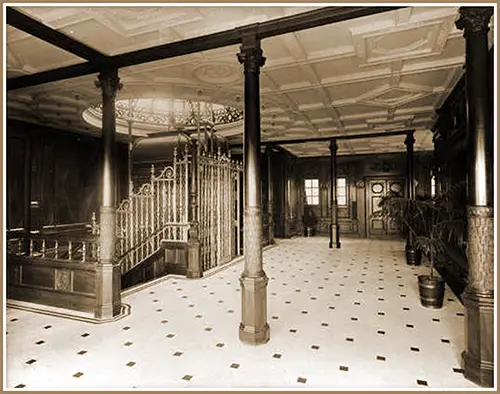
Entrance on the Boat Deck Showing Elevators (Lifts) on the RMS Mauretania. As the First-Class Passenger Accommodation Is Situated on Five Decks, Considerable Exertion Is Required to Go up the Staircase from the Lowest to the Uppermost Deck. Therefore, for the Comfort of the Passengers, Two Electrically Driven Passenger Elevators Have Been Fitted at the Main Stairway by Messrs. R. Waygood & Co., Limited, of London. These Lifts Have a Vertical Travel of 37 ft. 6 in., Extending from the Main to the Boat Decks. The Controller Is Magnetically Operated and Is Worked from the Car Utilizing a Special Car Switch Having an "Up," "Down," and " Stop " Position. The Lifts May Be Called from Any Deck, and an Electric Bell and Indicator Being Provided in Each Elevator. There are 14 Waygood Lift Elevators on the SS Mauretania. The Shipbuilder, November 1907. | GGA Image ID # 1bac150358

The First-Class Regal Suite Bedroom, Starboard Side, Looking Aft. With the Regal Rooms, One Is Immediately Impressed by an Air of Delicate Refinement throughout the Suite, Which Comprises a Drawing-Room, Dining-Room, Two Bedrooms, Bathroom, and Private Corridor, All Starting from the Main Alleyway on the Promenade Deck. The Shipbuilder, November 1907. | GGA Image ID # 1badbb4578

Plate LXXIV Fig. 66:- Lower First Class Dining Saloon on the Mauretania. The Height from the Floor of the Lower Dining Saloon to the Top of the Dome Is about 28 Feet. Immediately Abaft the Grand Entrance Is the Lower Dining Saloon, While Two Spacious Corridors on Each Side of the Ship Lead in the Opposite Direction to Numerous Staterooms. The Lower Dining Saloon Tables Accommodate 5 to 14 Passengers. Engineering Magazine, 8 November 1907. | GGA Image ID # 1bae798d75

Plate LXXVI Fig. 70:- First Class Lounge, Starboard Side, on the Mauretania. The First-Class Lounge or Music Room, Situated on the Boat Deck, Is 80 Ft. Long, 56 Ft. Wide, and Lift. 9 In. High. It Is a Noble Apartment, Treated in That Charming Style Obtained in France in the Last Quarter of the Eighteenth Century, and of Which the Petit Trianon Is Perhaps the Most Typical Example. The Arrangement of the Panels, and the Delicacy and Design of the Carvings and Columns, Might Have Been the Work of Gabriel or Miqué. Still, in His Scheme of Color, the Architect Has Been Inspired More by the Sumptuous Furniture of the Period than by the Wall Decoration, and That with the Happiest Result. Engineering Magazine, 8 November 1907. | GGA Image ID # 1bae98e560

Plate LXXVI Fig. 71:- Tapestry Panel at the First Class Lounge on the Mauretania. The "Mauretania's" First-Class Music Room and Lounge Stand Out, Perhaps, as the Prominent Feature of This Magnificent Vessel. It Is an Apartment of Immense Size and Palatial Decoration and Would Compare with the Best Hotels. It Is, indeed, Difficult to Realize That One Is on Shipboard. Engineering Magazine, 8 November 1907. | GGA Image ID # 1baea21c95

First Class Library and Writing Room on the Mauretania. The Library or Writing Room, a Somewhat Smaller Room than the Lounge, Is Situated on the Same Deck and Is Decorated in the Same Style, Although the Color Scheme Is Entirely Different. Many Passengers Will Probably Regard This Room as the Most Beautiful in Color on the Ship, Although We Have Inclined to Award This Distinction to the Lounge. The Wall Paneling Is of Sycamore Stained a Silver-Grey. The Veneering Has Been Selected to Bring Out the Fine Grain, the Plain Portions of the Wood Being Entirely Discarded. As in the Lounge, the Carved Moldings Are Gilt, but the Gold Used Has a Slightly Greenish Tint to Harmonize with the Paneling. A Bookcase Forms the Paneling of One Side of the Central Portion of the Room, the Delicate Carving and Gilt Trellis of the Doors Greatly Enhancing the Appearance of the Wall. On the Opposite Side of the Room Is a Carved Chimneypiece of White Statuary Marble Surmounted by a Mirror Similar in Design to the Central Doors of the Bookcase, which it Faces and Reflects. Engineering Magazine, 8 November 1907. | GGA Image ID # 1baeb0185b
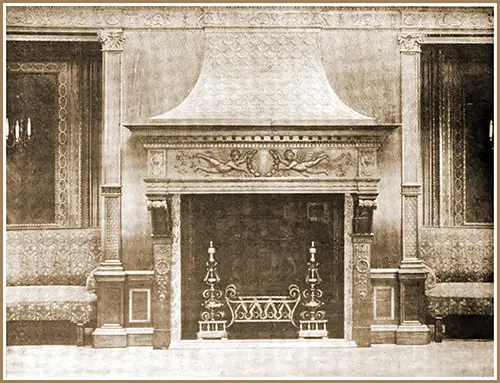
Fireplace in the First-Class Smoking Room on the RMS Mauretania. The Shipbuilder, November 1907. | GGA Image ID # 1bad7aabca

Ordinary Stateroom on D Deck of the Mauretania. Several More Ordinary Staterooms Are Provided on the Upper Deck, Fitted to Accommodate One, Two, or Three Passengers. They Are Furnished with Folding Lavatories, Dressing Tables, Sofas, and Wardrobes, the Furniture and Fittings Being Generally Similar to Those in the Rooms on the Main Deck. | GGA Image ID # 1bb1382e08

Plate XCIV Fig. 175:- Stokehold No. 3 on the Mauretania. Engineering Magazine, 8 November 1907. | GGA Image ID # 1baec62afc

Plate XCVII Fig. 186:- Pumping Engine Room on the RMS Mauretania. Engineering Magazine, 8 November 1907. | GGA Image ID # 1baee13ea5

Mauretania's Engines Showing Starting Platform. The Syren and Shipping, 1 January 1908. | GGA Image ID # 1baffec6e3

Mooring Buoy Now Laid Down for the "Lusitania" and "Mauretania" in That Famous Anchorage, the Sloyne, in the River Mersey. The Buoy, Which Is the Largest Yet Made, Is Securely Anchored. When the Ship's Cable Is Attached, She Rides Easily and Safely, There Being Ample Room for Her to Swing with the Tide. The Buoy Is So Large That to Transport It from London to Liverpool, an Ocean Liner—One of the Bibby Line—Had to Be Requisitioned, Its Conveyance by Rail or Coastwise Steamer Being Altogether Impossible. Cunard Daily Bulletin, Campania Edition, 24 January 1908. | GGA Image ID # 1ea0c86f9c

The RMS Lusitania and RMS Mauretania Are the Fastest Liners in the World and Hold All Atlantic Speed Records. With a Speed per Hour of over 25 Knots and a Gross Tonnage of 32,000, These Vessels Represent Perfection in Ocean Travel in the World at the Present Day. Cunard Daily Bulletin, Summer Number, 1912. | GGA Image ID # 1ea14de29f
Return to Content Links
- Did the Mauretania help the titanic?
- The RMS Mauretania was on a westbound voyage from Liverpool to New York beginning on 10 April 1912. Since the Mauretania was docked at Queenstown, Ireland, during the RMS Titanic disaster, the ship did not factor into the rescue operations for the Titanic.
- What is the Mauretania famous for?
- For 28 years, the Mauretania played a poignant part not only in the maritime history of the world but in business life, as well as being of invaluable service to the United States in times of war. When launched in 1907, the Mauretania was the largest ship ever built by man. For almost 22 years, she remained the fastest liner ever produced. Even after losing her world championship for size and speed, she remained the world's most famous steamship. It wasn't just her size or speed that had given the Mauretania her fame. That rested on something more secure and intangible — on her personality, for the Mauretania was a ship with a fighting heart.
- Did the Mauretania sink?
- No. The Mauretania (1906) was scrapped and dismantled in Rosyth, Scotland, to the dismay of her most loyal patrons. Most of her furnishings were sold before or during the scrapping process.
- How long did it take the Mauretania to cross the Atlantic?
- The RMS Mauretania was an Express Liner capable of over 26 knots top speed. She could cross the Atlantic, either eastbound or westbound, in about 4 1/2 days.
Return to Content Links

Cunard Record Passages and Time at Sea. RMS Mauretania Passenger List, 30 April 1921. | GGA Image ID # 1e31b589a7
30 November – 5 December 1907 Fastest Eastbound Crossing of the Atlantic with an Average Speed of 23.69 knots.
26 to 30 September 1909 Blue Riband for the fastest westbound crossing in 4 days, 10 hours, and 51 minutes with an average speed of 26.06 knots. Mauretania maintained that record for 20 years, losing it to Norddeutscher Lloyd's liner Bremen in July 1929.
Blue Ribands
- Holder of the Blue Riband Westbound Record 1909-1929
- Holder of the Blue Riband Eastbound Record 1907-1929
Return to Content Links
"The Cunard Turbine-Driven Quadruple-Screw Atlantic Liner 'Mauretania' Constructed by Messrs. Swan, Hunter, and Wigham Richardson, Limited, Wallsend-on-Tyne, Engine by The Wallsend Slipway and Engineering Company, Limited, Wallsend-on-Tyne," in Engineering, London: Offices of Engineering, 1907.
"Monarchs of the Seas: Cunard Liners 'Lusitania' and 'Mauretania,' the Largest Ships in the World," in The Master Mate and Pilot, New York: The American Association of Masters, Mates, and Pilots, Vol. 1, No. 1, June 1908, pp. 20-25.
"The Ship of the Year. Cunard Express Liner 'Mauretania,' Built by Messrs. Swan, Hunter, and Wigham Richards, Ltd., Wallsend-on-Tyne," in The Syren and Shipping Illustrated, Vol. XLVI, No. 592, 1 January 1908, pp. 30-39.
A. G. Hood and H. Bocler, Compilers, "The Cunard Express Liner 'Mauretania.'" In The Shipbuilder: A Quarterly Magazine Devoted to The Shipbuilding, Marine Engineering, and Allied Industries, Vol. II, Special Number, November 1907.
Frederick A. Talbot, Steamship Conquest of the World, London: William Heinemann, 1912.



